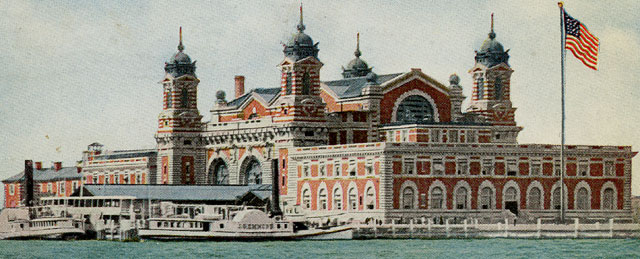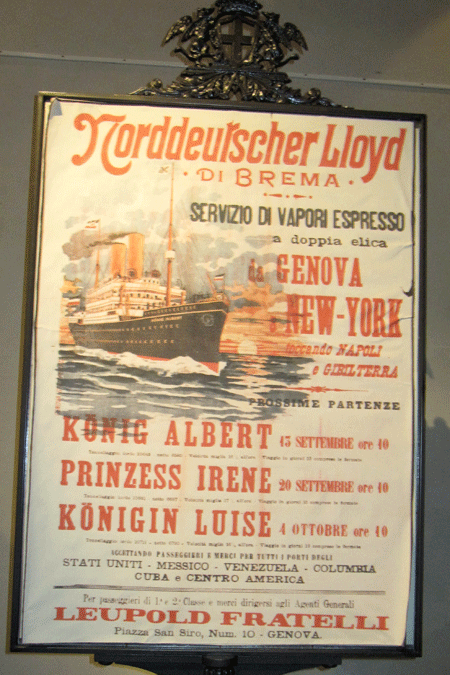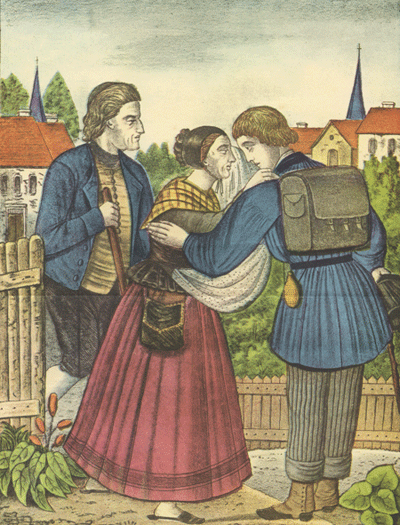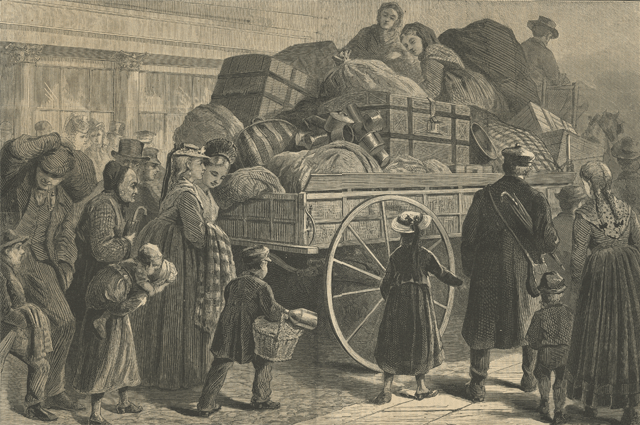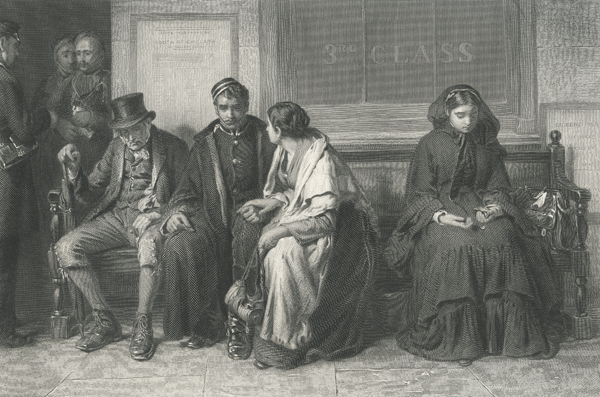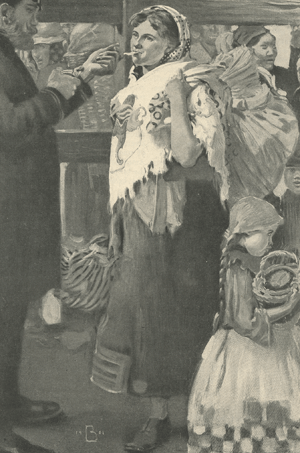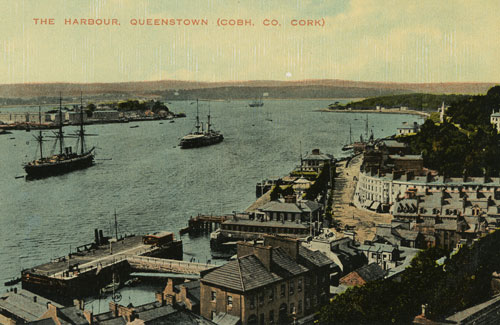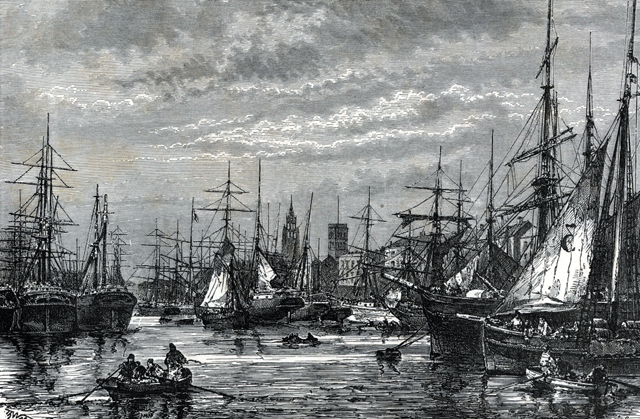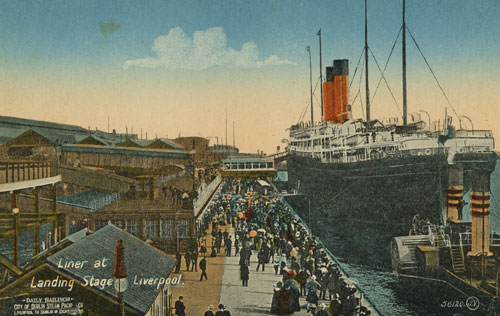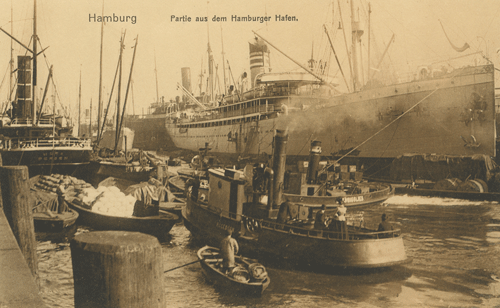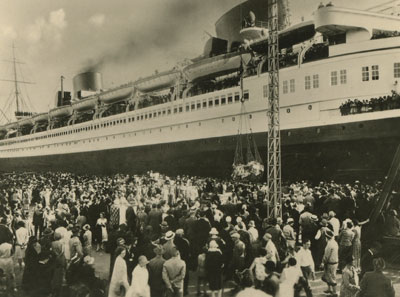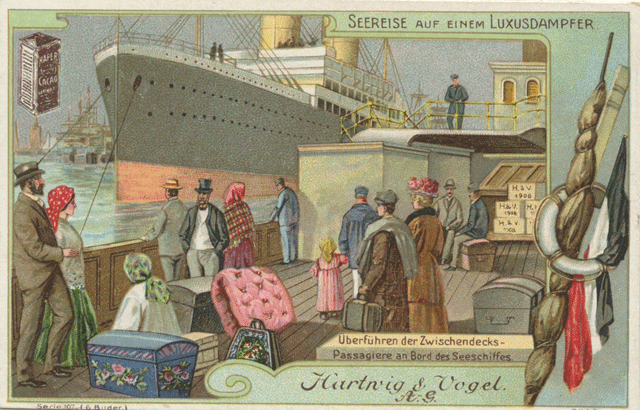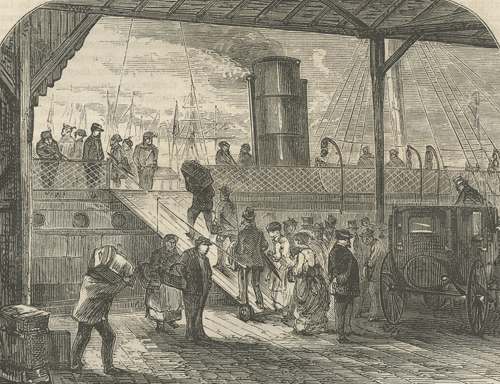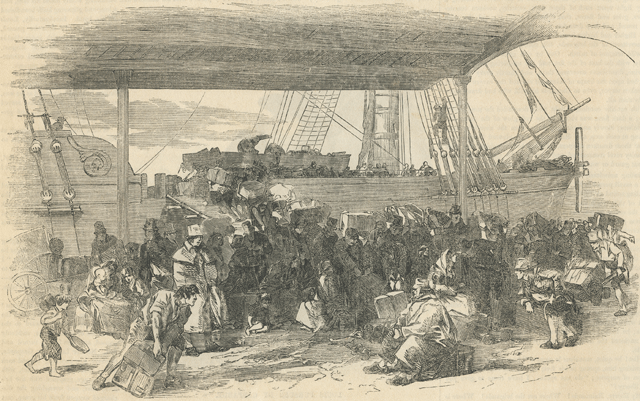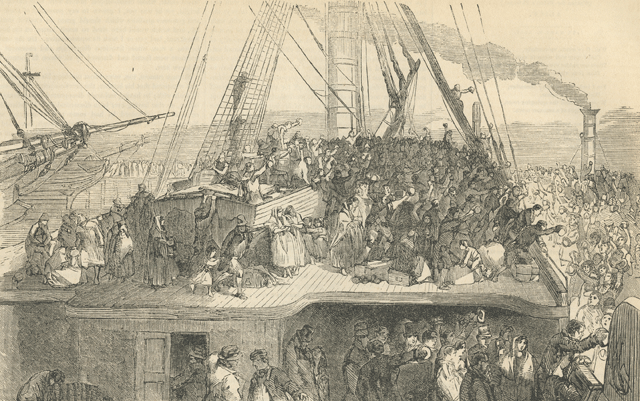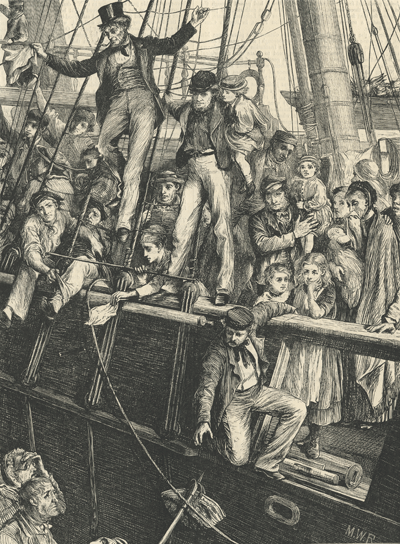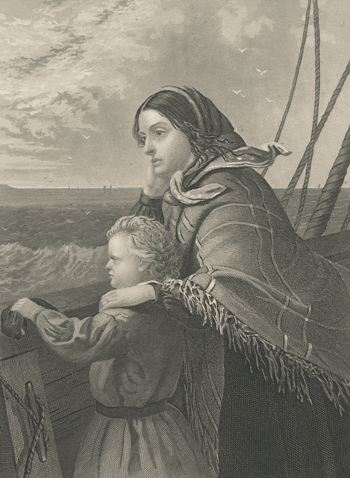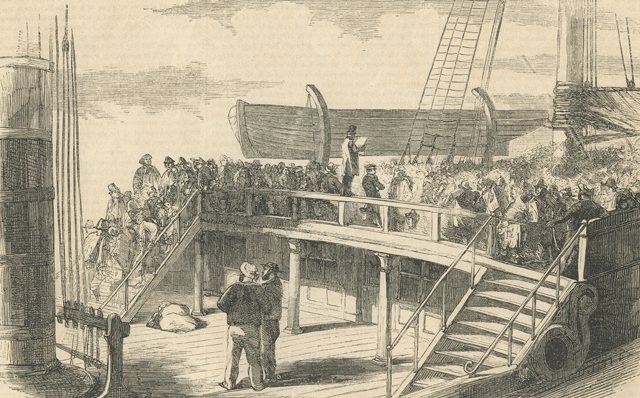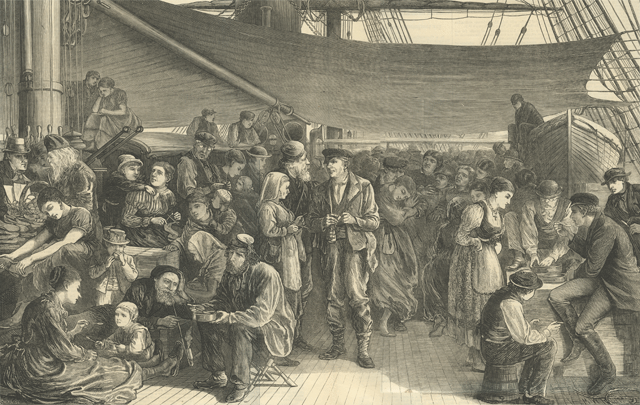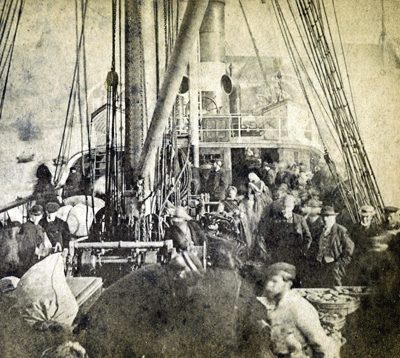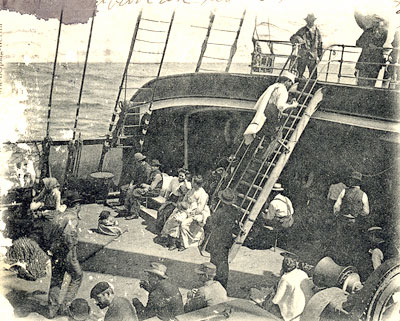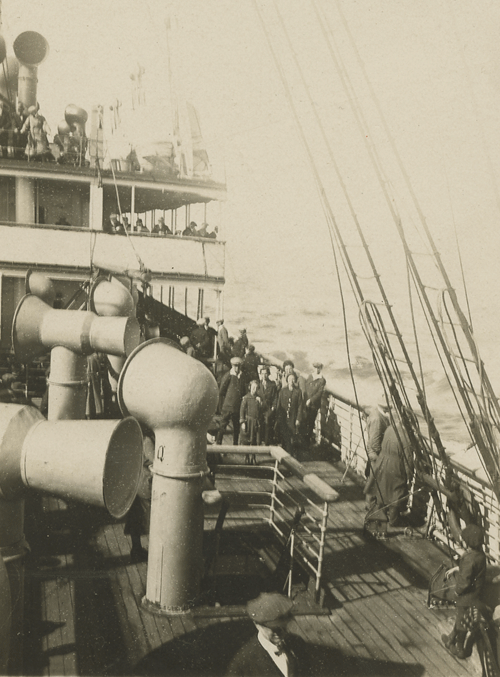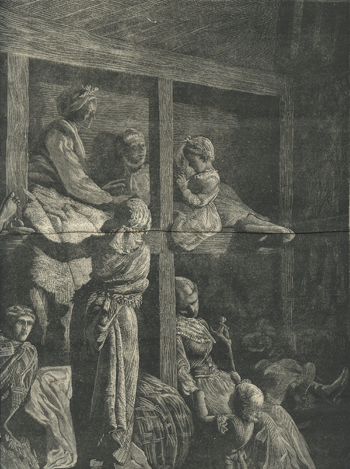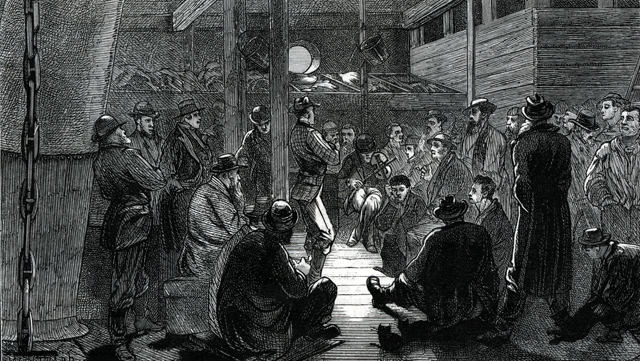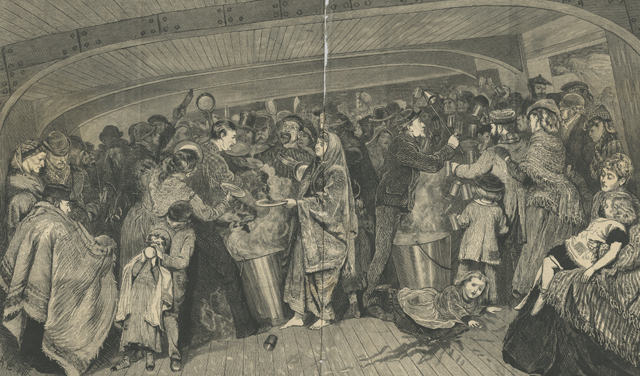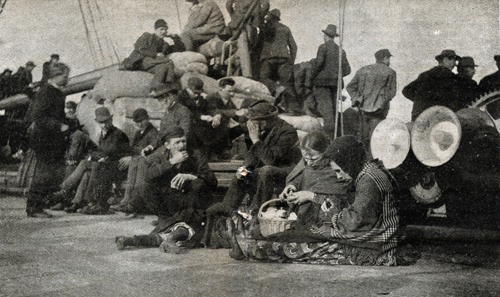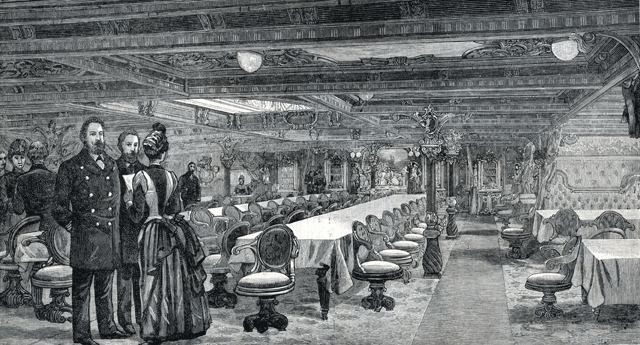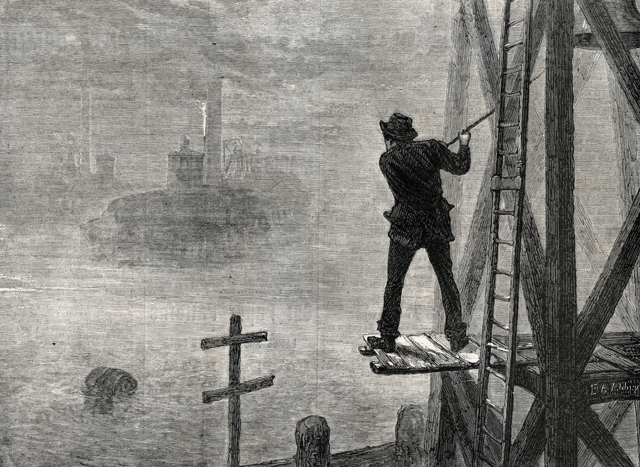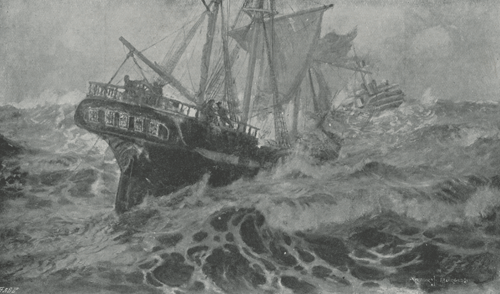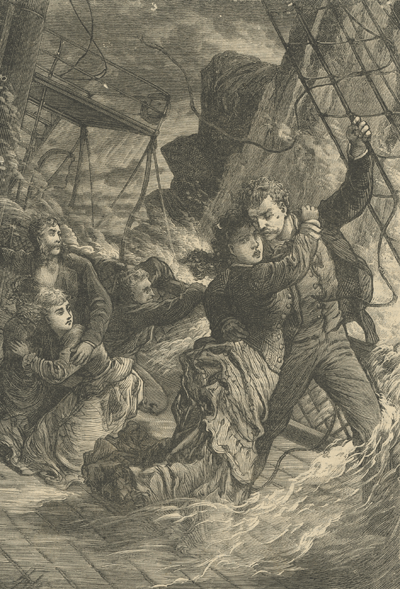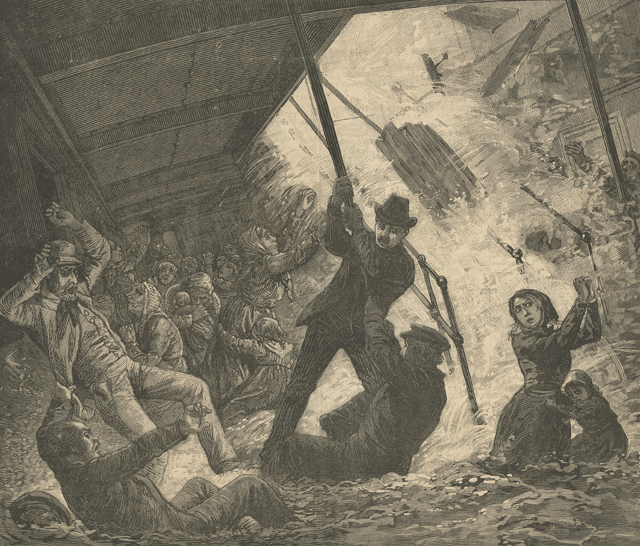|
Quarantine
By 1846 all vessels coming into New York Harbor were technically subject to quarantine inspections.
The incoming ships were inspected when they arrived in the Lower Bay off Statin Island.
For images of the quarantine stations and for more information on the quarantine inspections go to
QUARANTINE now or at the bottom of the page.
See also CHOLERA 1892 now or at the bottom of the page.
|
The Arrival in New York Harbor
|
|
After clearing quarantine the ship moved forward into New York Harbor proper where the
passengers, depending, of course, on the date of their arrival, were greeted by the
famous sight of Lady Liberty.
The dedication of the statue took place in October 1886.
Until 1855 ships disembarked their passengers as soon as they cleared quarantine. Passengers
were not offloaded directly to the docks but into lighters which took them to shore. Immediately
upon his arrival the immigrant was besieged by all sorts of scam artists and thieves who
robbed luggage, sold phony tickets to points west and generally made live miserable for the immigrant. Julius Lindemann,
Catherine and Louis Furst arrived during this period.
In October of 1858 the German Societies of the United States called for Congress to pass a bill for the protection of
emigrants on ship board and after their arrival in the United States. They asked for: separate sleeping quarters for
females and males (except for married couples), only qualified surgeons be employed as ships doctors, a guarantee of
the safe delivery of luggage, and control of the purchase of rail and canal boat tickets to points west in the United States.
|
|
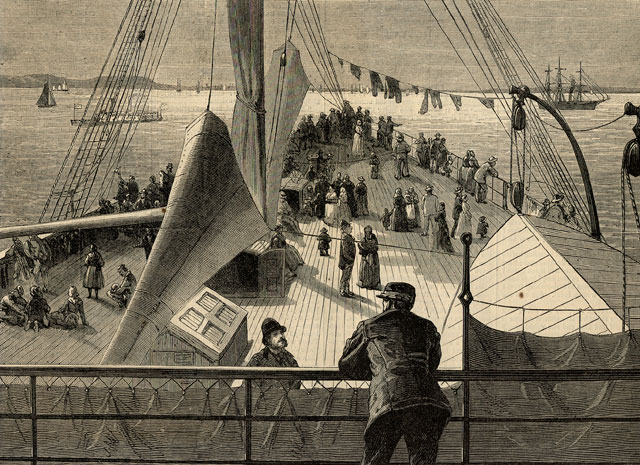 |
| Collection of Maggie Land Blanck
|
| First Sight of New York Bay - Arrival of a European
Steamer. -
Harper's Weekly, June 2, 1877
|
|
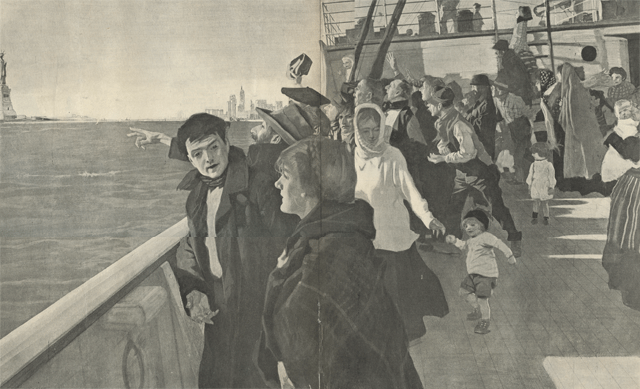 |
| Harper's Weekly, Not dated, Collection
of Maggie Land Blanck
THE LAND OF PROMISE, DRAWN BY FRANK CRAIG
Frank Craig was a known artist. See
Frank Craig
|
|
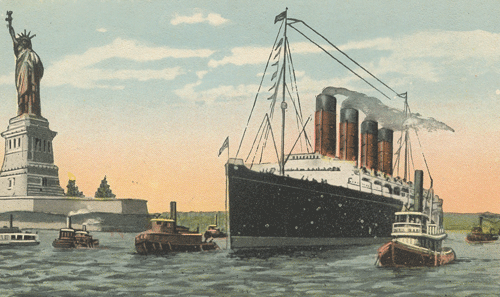 |
| Postcard collection
of Maggie Land Blanck "America's Welcome, Statue of Liberty, New York Harbor"
printed on top of image in border.
Printed on back: "AMERICA'S WELCOME, Statue of Liberty, New York Harbor at
night. Here can be seen one of the mighty ocean liners which sail through New York
Harbor daily. The arriving visitor and the home-coming traveler get America's
Welcome from the colossal
Statue of Liberty as the boat enters upper New York Bay at night. The blazing torch on
Statue of Liberty held 306 feet above the water lights the harbor and can be seen
many miles away."
I may be wrong, but this boat looks to be leaving, rather then entering the harbor.
Liberty faces east, so the boat should be coming from the other direction if it was
entering the harbor.
|
|
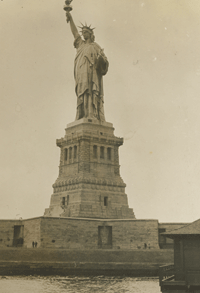 |
| Postcard collection
of Maggie Land Blanck
|
|
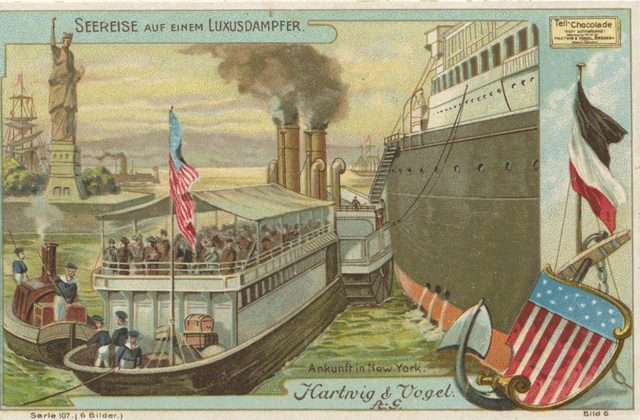 |
| Trading card
collection
of Maggie Land Blanck
Seereise auf eine Luxusdampfer [Cruse on a luxury steamer]
Ankunft in New York [Arrival in New York]
Printed on back;
Die Fahrt uber der grossen Teich nahert sich dem Ende.
Obgleich man noch immer nur Himmel und Wasser sieht, trifft man doch haufiger mit anderen Schiffen zusammen. Es ist ublich dass begegnende Schiffe
durch Flaggen Grusse wechsein.
Amerikaner
salutieren
z. B. meistens "Herzlich willkommen" und die einfahrenden Dampfer hissen unter ihrer Nationalflagge "Herzlichen Dank!"
Bald erkennet man von weitem die insel Long-Island
bei New York
mit der darauf befindlichen Freiheits-Statue und in der Ferne zeigen
sich schon die Wolkenkratzer der grossten Stadt der neuen
der neuen Welt. Nur noch kurze Zeit, die Anker sinken
ken in die
Tiefe und die Reisenden verlassen das Schiff. Das Ausladen vollzieht
sich wie vorher das Anbordnehmen geschah, meist flott und ohne Zwischenfall.
[The ride over the big pond comes to an end. One still sees only sky and water but
one also sees more vessels. It is customary when encountering such ships to exchange
flag
salutes. The Americans, for example signaling "Most Welcome" and the steamer under
its national flag replying "Thanks".
Soon you recognize from a distance the island of Long Island then New York
and the Statue of Liberty and in the distance you see
the skyscrapers of the largest city in the new world. In no time
the anchor is dropped
and the passengers have left the ship. The unloading
takes place as when boarding, usually quickly and without incident.]
|
|
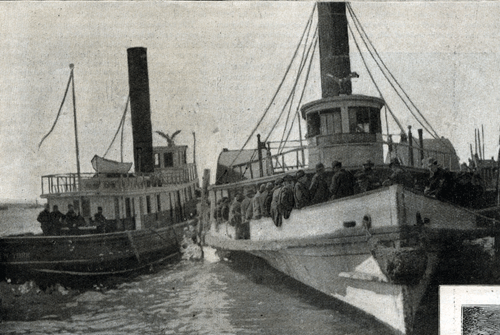 |
| Print
collection
of Maggie Land Blanck
TRANSFERRING IMMIGRANTS FROM STEAMER TO THE BATTERY
Frank Leslie's Illustrated Newspaper June 13, 1891
At this time the procession center for immigrants was the Barge Office.
|
|
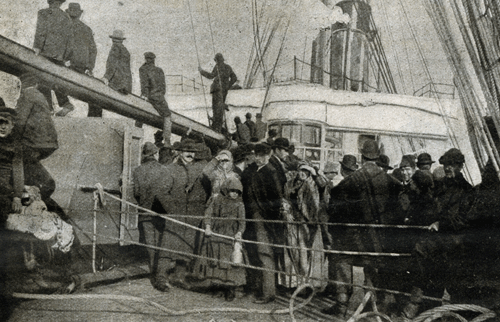 |
| Print
collection
of Maggie Land Blanck
ROPED OFF FOR INSPECTION
Frank Leslie's Illustrated Newspaper June 13, 1891
|
|
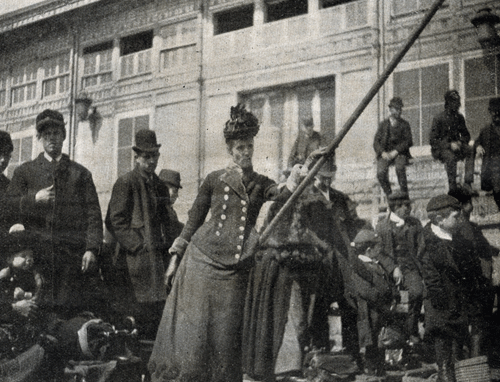 |
| Print
collection
of Maggie Land Blanck
WAITING FOR PERMISSION TO GO ASHORE
Frank Leslie's Illustrated Newspaper June 13, 1891 According to the head lines for
this article "four thousand immigrants were recently landed in a single day (May 5th)"
|
|
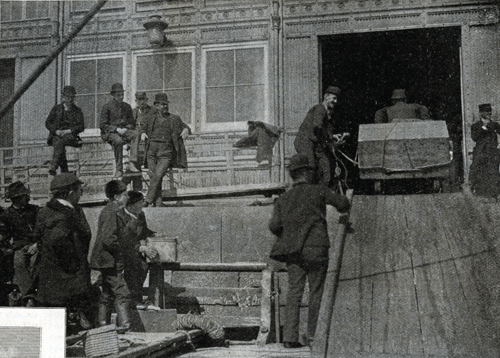 |
| Print
collection
of Maggie Land Blanck
BAGGAGE TRANSFERED FROM THE STEAMER TO THE WHARF
Frank Leslie's Illustrated Newspaper June 13, 1891
|
|
|
After 1837 every ship entering a port in the United States was required to have a manifest indicating the name of the ship, the port from which it sailed, the date of its arrival in the US and a list of all passengers, indicating their age, sex, occupation, and nationality.
Early manifests frequently do not offer enough information to distinguish between one
Katie Walsh from Ireland and another Katie Walsh from Ireland, making it very difficult to
pinpoint
early dates of immigration. Later manifests contained more information including addresses of
relatives in the old country and relatives in the new country making it somewhat clearer who
was who. Even later manifests included height, hair and eye color and other information.
The date of immigration determines how much information can be cleaned from the ship manifests.
There is a very popular myth that names were changed at Ellis Island. This did NOT happen.
The manifests were made at the port of imbarkation or during the voyage so the name on the manifest was determined in
whatever port the immigrant left from, NOT when they arrived in the USA.
|
|
| Castle Gardens
Because of the large increase in immigration in the mid 1800's and in an effort to protect the newly arriving immigrant from scam artists, the State of New York opened an immigration processing center at Castle Gardens on August 1, 1855.
Castle Garden, located at the lower tip of Manhattan, is now the Castle Clinton National Monument.
Built in 1807 as an artillery defense fort to protect the New York harbor it was called West Battery.
After the war of 1812 the name was changed to
Fort Clinton. Originally it stood about 300 feet off shore and was connected to the mainland by a causeway. It
has gradually been connected by landfill to Battery Park. In 1824 the fort was enclosed and became a popular
theater called Castle Garden with a seating capacity of 6,000. After Ellis Island was opened in 1892 the building was turned into an Aquarium. It was closed in 1941 for the construction of the Brooklyn-Battery Tunnel and the Aquarium subsequently moved to the Bronx Zoo. Robert Moses wanted it demolished but there was enough opposition that it was preserved and in 1950 it was declared a national monument and became the property of the U. S. Department of Interior. It was restored in the 1970s and now contains the ticket offices for the ferries to the Statue of Liberty and Ellis Island.
The complex that made up the Castle Gardens immigration center included outbuildings,
hospital and offices. It was all enclosed by a large wooden fence.
The ships let the first class and cabin passengers off at a pier and then
proceed to Castle Garden where the steerage passengers disembarked. All immigrants
had to land at the depot, which was closed to everyone else, like the scam artists and
thieves. Each immigrant had his name checked against the ship manifest,
underwent a brief medical exam and passed through customs.
|
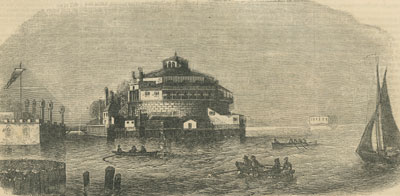 |
Castle Garden, From the River
Gleason's Pictorial, Boston, Saturday January 10, 1852.
|
| Print collection of Maggie Land Blanck
|
|
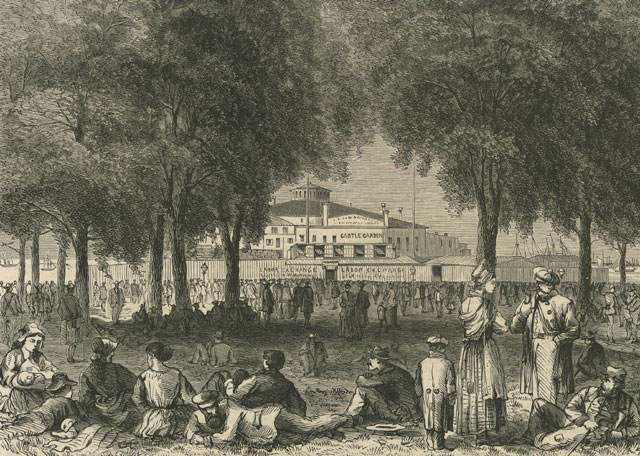 |
| Print collection of Maggie Land Blanck
The Labor Exchange - Emigrants on the Battery in front of Castle Gardens, New York
Harper's Weekly August 15, 1868
|
|
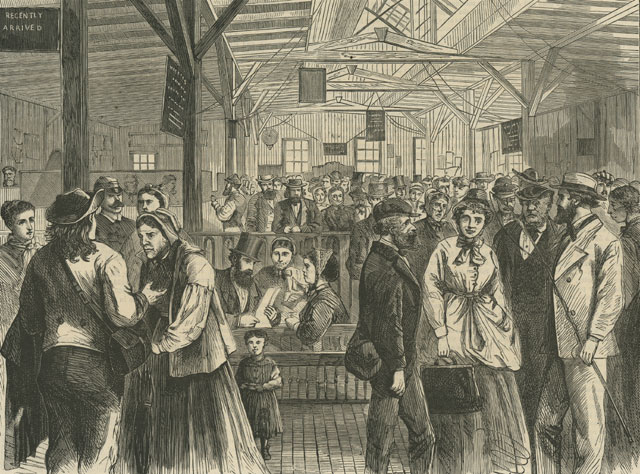 |
| Print collection of Maggie Land Blanck
The Labor Exchange - Interior View of the Office at Castle Gardens, New York
Harper's Weekly August 15, 1868
|
|
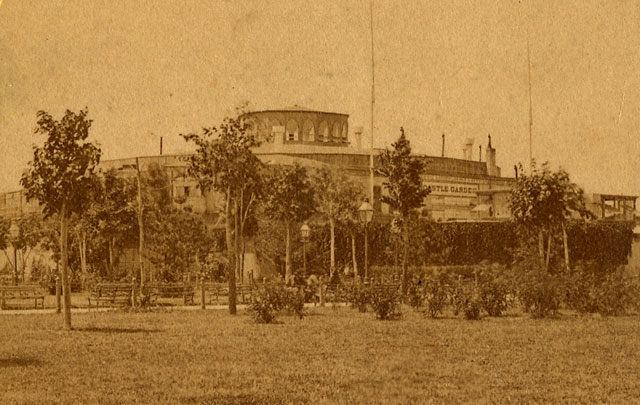 |
| Collection of Maggie Land Blanck
|
| Castle Gardens. Photographed and Published by B. W. Kilburn - Littleton, N. H., 1891
|
|
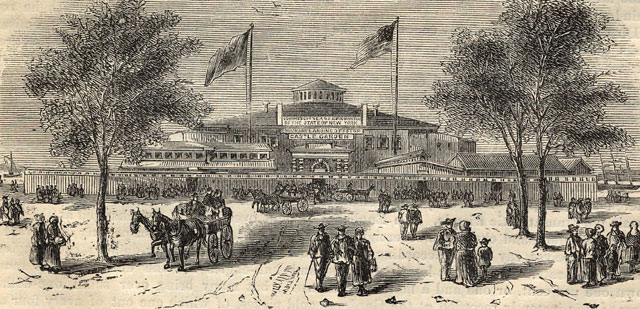 |
| Collection of Maggie Land Blanck
|
| Castle Gardens- Exterior View From The Battery - Harpers 1871
|
|
 |
| Collection of Maggie Land Blanck
|
| Interior of Castle Gardens- Harpers Weekly September 2, 1865
|
|
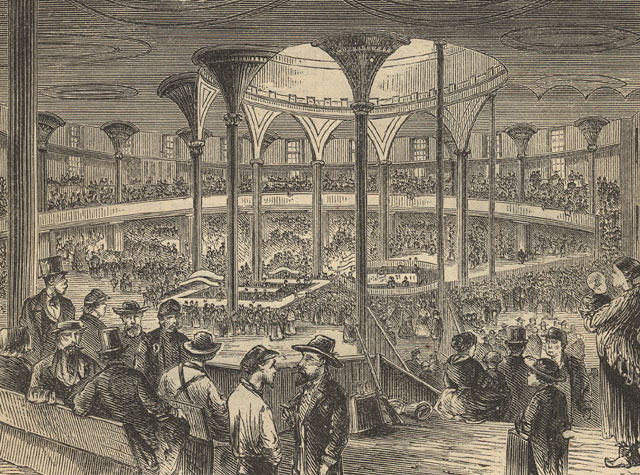 |
| Collection of Maggie Land Blanck
|
| Interior of Castle Gardens- Harpers 1871
|
|
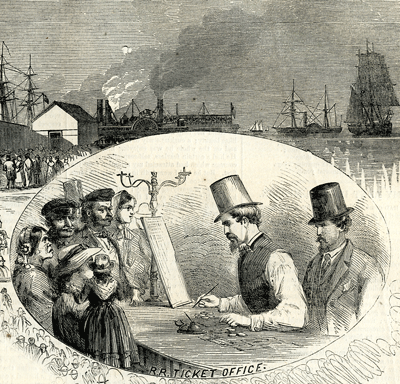 |
| Collection of Maggie Land Blanck
|
| R. R. Ticket Office — Harpers Weekly September 2, 1865
|
|
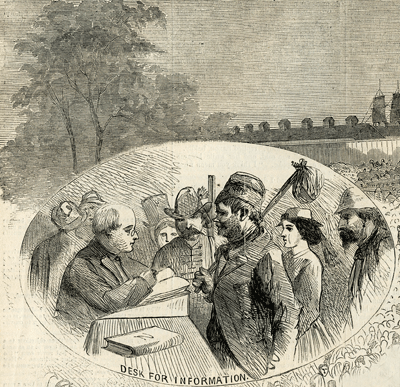 |
| Collection of Maggie Land Blanck
|
| Desk for Information — Harpers Weekly September 2, 1865
|
|
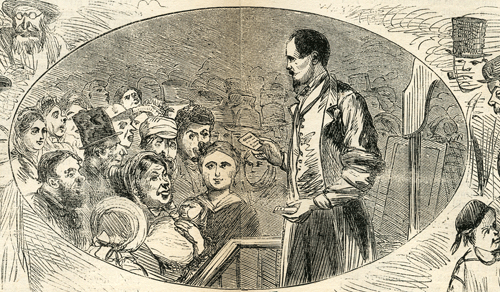 |
| Collection of Maggie Land Blanck
|
| Called For — Harpers Weekly September 2, 1865
|
|
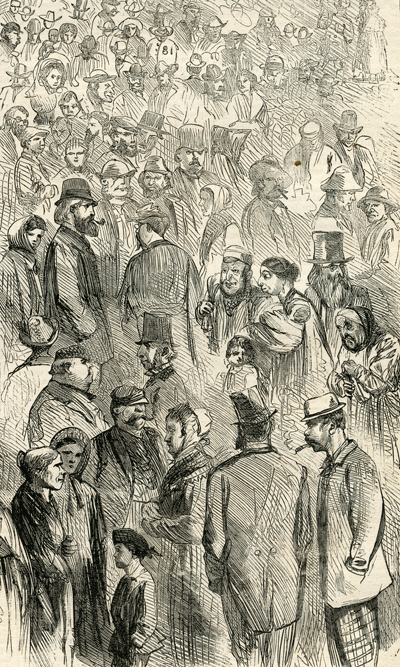 |
| Collection of Maggie Land Blanck
|
| Harpers Weekly September 2, 1865
|
|
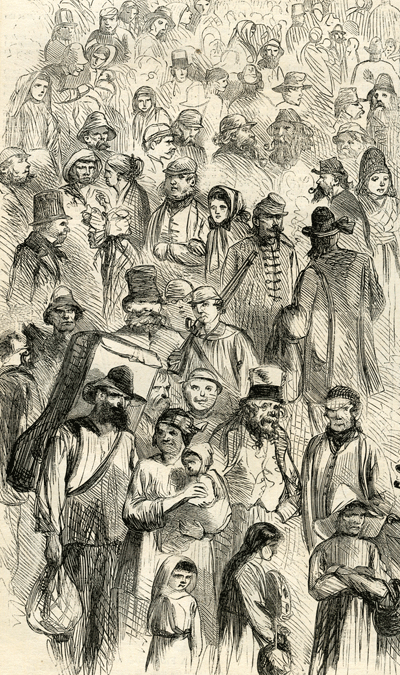 |
| Collection of Maggie Land Blanck
|
Harpers Weekly September 2, 1865
"Since 1847 about three million of emigrants have arrived at this port. Last year
the number of these was 182,916, being an increase of 30,000 over the pervious year. The largest number on record
is 319,223 — the number of arrivals in 1854. If we take the number of arrivals
at this port in 1864 we shall find that 90,000 were from Ireland,
nearly 60,000 from Germany and about 24,000 from England. These countries are the main
sources of emigration."
|
|
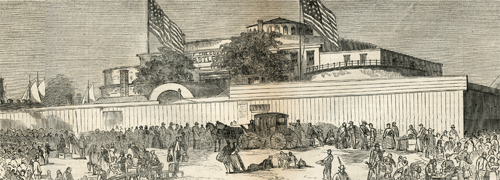 |
| Collection of Maggie Land Blanck
|
| Outside the depot — Harpers Weekly September 2, 1865
|
|
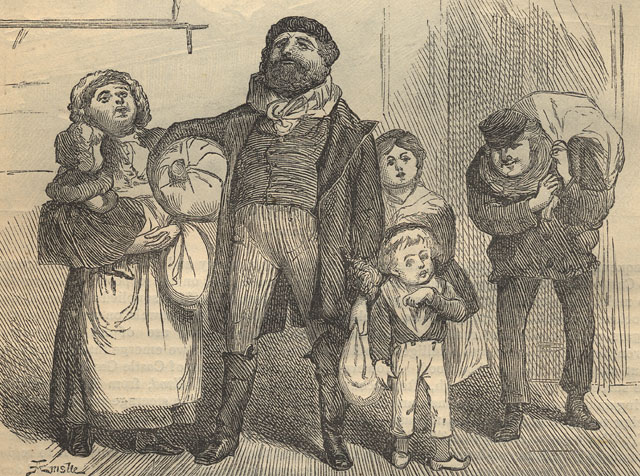 |
| Collection of Maggie Land Blanck
|
| Harpers 1871
The Harpers Weekly article that accompanied this picture claimed that a person's nationality could be determined by their dress.
"It is curious to see such a heterogeneous crowd land. The Swedes are usually distinguished by their
tanned-leather breeches and waistcoats, and their peculiar before mentioned exhalations; you can
not miss the Irishman with his napless hat, worn coat, and corduroy trousers; the Englishman
you know by his Scotch cap, clay pipe, and paper collar. The Teuton you detect at once by his long-shirted,
dark blue woolen coat, high necked and brass-buttoned vest, and flat military cap or gray beaver.
Indeed, one of the officers told me that he could tell exactly what part of Germany each individual
came from his dress alone, and I believe he could. Then there are the Bohemians (the genuine ones)
with their many-colored scarfs and glaring jackets for the women, and natty military caps for
almost all the men; the French in their blue linen blouses; and finally the Norwegians ;in their
curious national dress, consisting of a gray woolen stiff-necked jacket, which covers only about one-third
of their back, whine in front it slopes down to a greater length, and is profusely ornamented with huge silver
buttons set so close together that they overlap each. Their breeches, of dark woolen stuff, there from
reach nearly up to their neck behind, only a small strip of jacket with an enormous still collar between.
You can not properly say a Norwegian in a pair of breeches, but a pair of breeches with a Norwegian in them.
This, of course, only applies to the farmers from the interior parts of the country, the "Dalkeller" and "Troensere, "
etc."
|
|
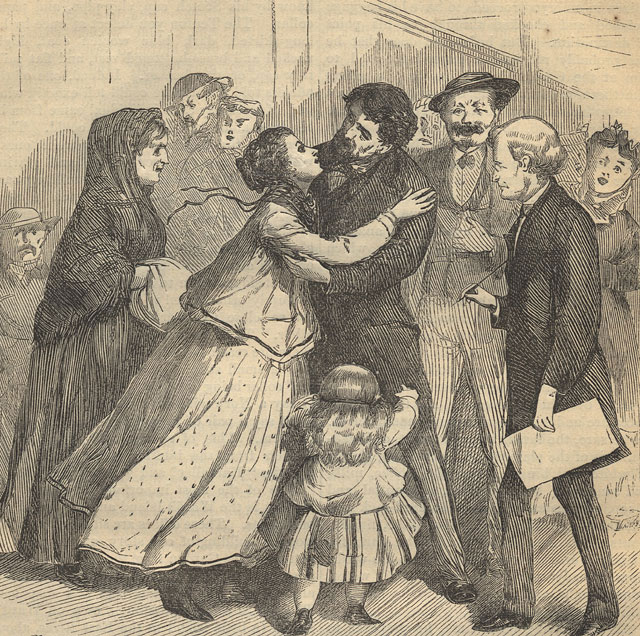 |
| Collection of Maggie Land Blanck
|
| Meeting of Friends - Harpers 1871
Ship arrivals were published in the paper so friends and family knew when to come and meet the boat.
|
|
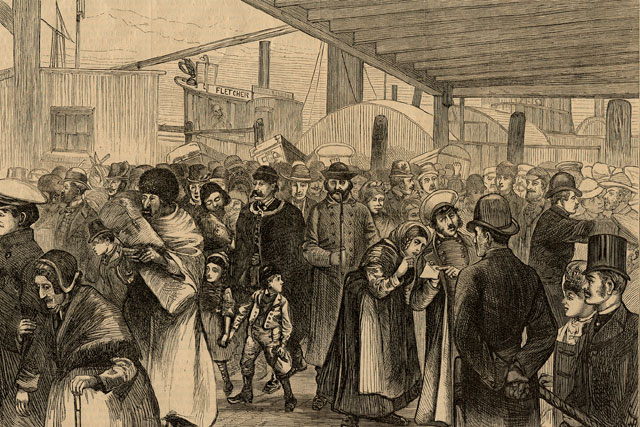 |
| Collection of Maggie Land Blanck
|
| Immigrants Landing At Castle Garden - Harper's Weekly, May 29, 1880
|
|
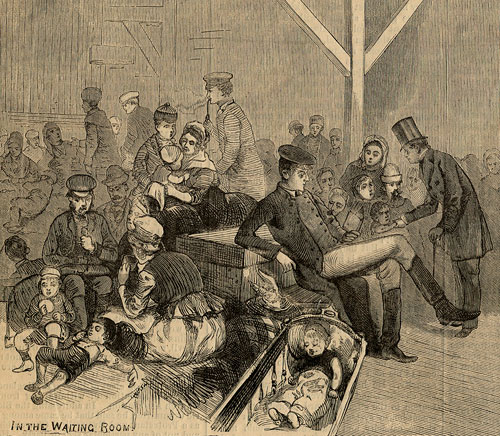 |
| Collection of Maggie Land Blanck
|
| In The Waiting Room - Harper's Weekly, May 29, 1880
Services were provided to exchange money into US currency, purchase railroad tickets
(if the immigrant was going on to further points), forward luggage (if needed) and generally
give aid and assistance to the immigrant. There was a telegraph office and a mail service. Many
immigrants had letters waiting for them with money enclosed for the next step of the journey. Multilingual
assistants were available to resolve the myriad of problems that arose. A frequent problem
was that the immigrant would have the wrong or insufficient information to get him to his final destination.
For example he may have the address "Farmington, United States". How to determine which of the 21
states that had towns named Farmington was correct? This happened at a later date with the
Parnegians who had the address, "Lawrence, Rhode Island" instead of Lawrence, Massachusetts. How many people ended up somewhere entirely different from what they started out for?
The amenities at Castle Gardens included two wash rooms, one for men and one for women.
There was hot water, soap and towels, all free to the immigrant.
The garden was heated in the winter and in warm weather there was a cooling fountain.
There were no beds at Castle Gardens and immigrants were encouraged to go on their
way the same day they had arrived. People were however, permitted to sleep in the galleries.
Sometimes as many as 3,000 spent the night. Castle Garden remained the New York
processing center for immigrants until April 1890. From April 1890 until
Ellis Island was opened in January 1892 immigrants were processed through the Barge Office.
See below.
|
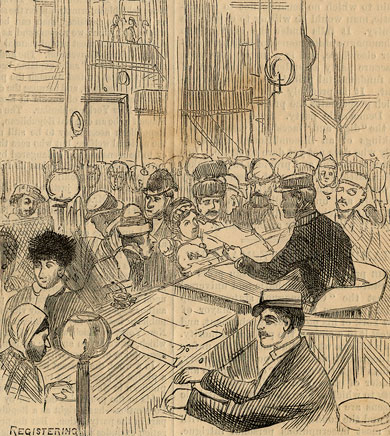
|

|
| Collection of Maggie Land Blanck
| Collection of Maggie Land Blanck
|
| Registering
| The Labor Bulletin
|
| Harper's Weekly, May 29, 1880 |
|
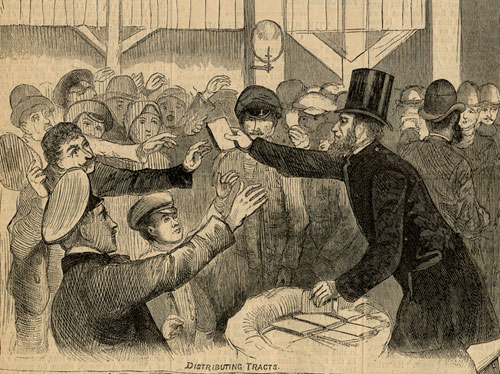 |
| Collection of Maggie Land Blanck
|
| Distributing Tracts - Harper's Weekly, May 29, 1880
|
|
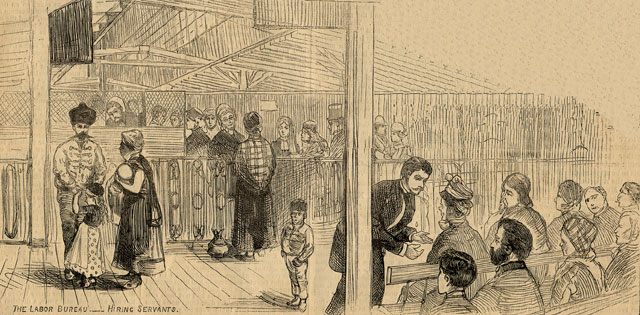 |
| Collection of Maggie Land Blanck
|
| The Labor Bureau ---- Hiring Servants -Harper's Weekly, May 29, 1880
Castle Gardens also contained a "labor exchange" where jobs were posted and where a newly arrived
immigrant might find employment. |
|
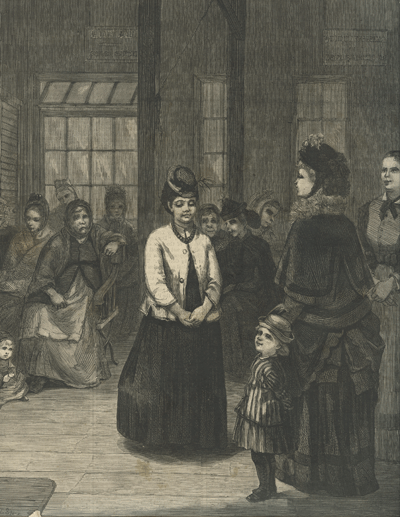
|
| Harpers Weekly January 25, 1873
collection of Maggie Land Blanck
THE LABOUR EXCHANGE AT CASTLE GARDEN - CHOOSING A GIRL
|
|
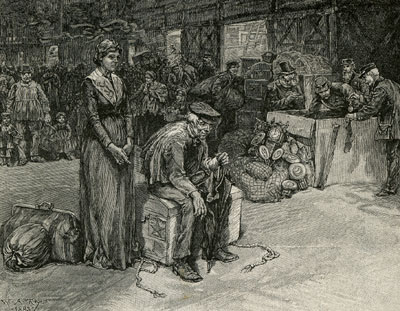 |
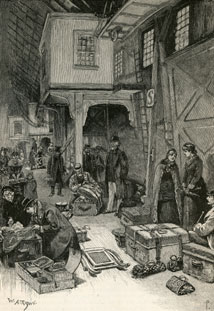 |
| Print Collection of Maggie Land Blanck
Inspection of luggage by costumes officials. The first picture is of the "immigrant's baggage"
and the second is of "cabin passengers' baggage on the dock" Harper's New Monthly Magazine, June 1884
|
|
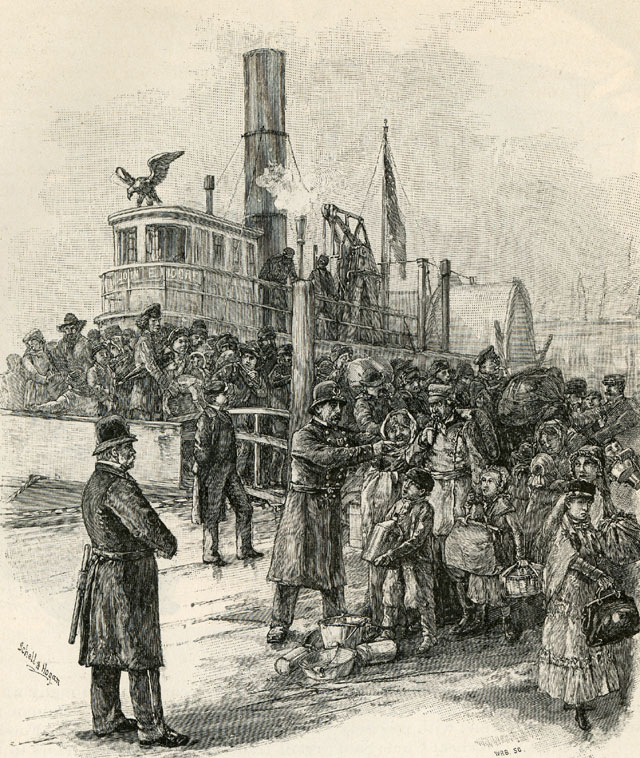 |
| Magazine collection of Maggie Land Blanck
"Landing Immigrants at Castle Gardens"
Harper's New Monthly Magazine, June 1884
|
|
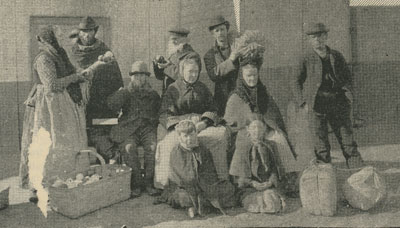 |
Historic America: Castle Gardens (1890), New York, The
Illustrated American March 1, 1890
|
| Magazine collection of Maggie Land Blanck
|
|
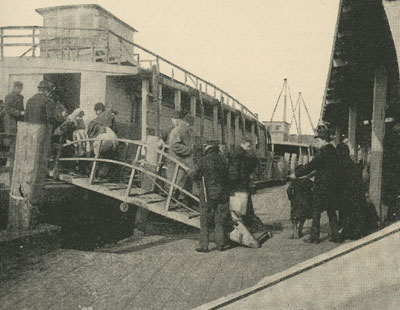 |
Historic America: Castle Gardens (1890), New York, The
Illustrated American March 1, 1890
|
| Magazine collection of Maggie Land Blanck
|
|
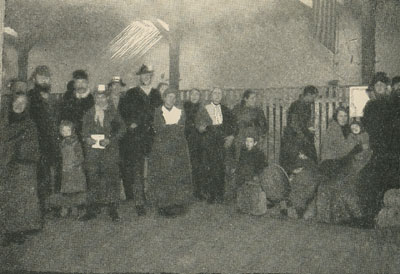 |
Historic America: Castle Gardens (1890), New York, The
Illustrated American March 1, 1890
|
| Magazine collection of Maggie Land Blanck
|
|
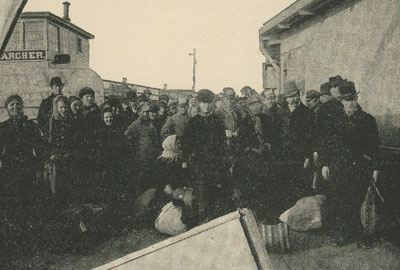 |
Historic America: Castle Gardens (1890), New York, The
Illustrated American March 1, 1890 The light corners that are sticking into
several of these
images are because the arrangement of the page has the images overlapping.
|
| Magazine collection of Maggie Land Blanck
|
|
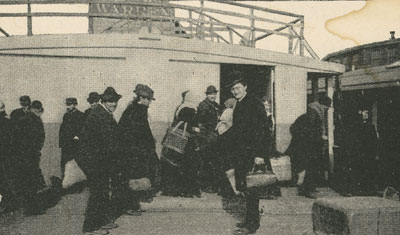 |
Historic America: Castle Gardens (1890), New York, The
Illustrated American March 1, 1890
|
| Magazine collection of Maggie Land Blanck
|
|
|
| 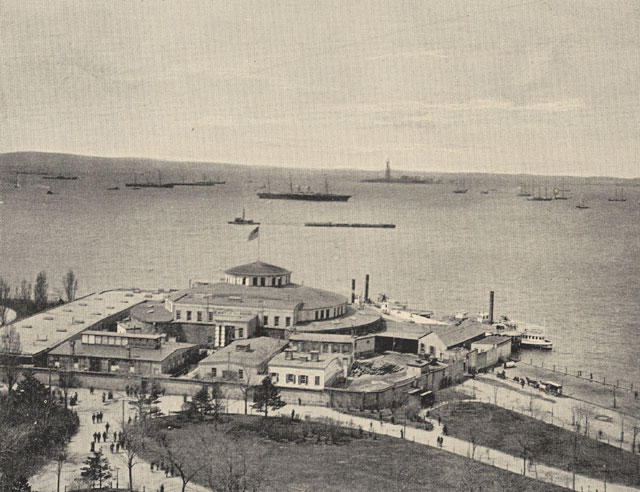 |
| Collection of Maggie Land Blanck
|
| Castle Gardens, Date Unknown
I have another image of Castle Gardens with all of the same support buildings
that is from the Illustrated
America dated 1890. That image is not as clear as this one.
|
|
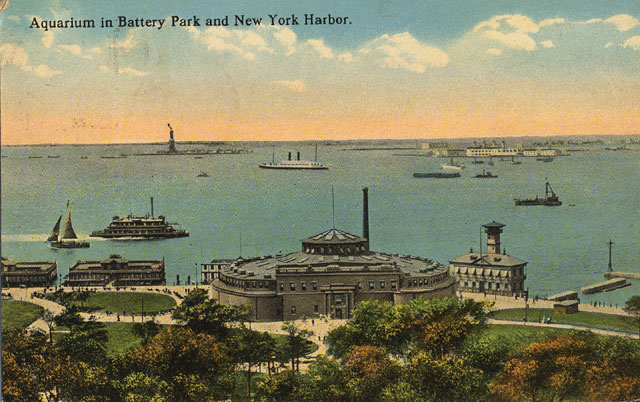 |
| Collection of Maggie Land Blanck
|
| Aquarium in Battery Park and New York Harbor
Posted 1910
Printed on back: The Aquarium, formerly known as Castle Garden Fort, is located at the
foot of Battery Park, and is open to the public daily from 9 a. m. to 5 p.m. Here can be seen in large
glass tanks, the most valuable and complete collection of fish, seals, turtles and other deep sea
inhabitants in existence. At the entrance of the harbor is the Statue of Liberty and a little further up
is Ellis Island through which all immigrants landing in New York City must pass.
The building to the right of the Aquarium was the Fire Boat Station where the fire boats docked.
Also known as the Firehouse, the NYPL has an image taken in May 1936.
NYPL . Thanks to Barb for sending info and the photo connection.
|
|
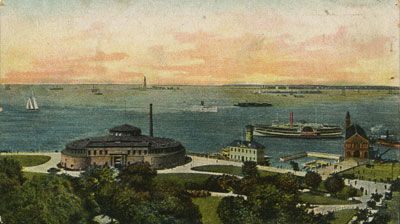 |
New York Harbor Posted 1910.
Notice in the two 1910 images all of the surrounding buildings seen in the 1890 images have
been removed and new buildings have been erected on the pier.
|
| Postcard collection of Maggie Land Blanck
In March 2009 Bob Alexander shared a postcard that showed this exact image but had "Aquarium
and New York Harbor" printed on the front.
In Bob's postcard it was possible to read the name of the paddlewheel boat on the right.
It was the infamous
SS General Slocum which burned on June 15, 1904 killing over a thousand people.
This, of curse, means that this image was taken before 1904.
See
General Slocum
|
|
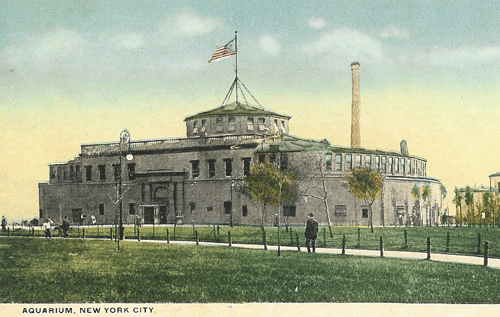 |
|
From the Collection of John T. Chiarella
|
|
In August 2008 John T Chiarella shared this image of Castle Gardens.
Printed on back.
"Aquarium in Battery Park and New York Harbor.
The Aquarium formerly known as Castle Garden Fort is located at
the foot of Battery Park and is open to the public daily from
9 A. M. to 5 P. M. . Here can be seen in large glass tanks the most valuable and complete
collection of
fish, seals, turtles and other deep sea inhabitance in existence.
At the entrance
to the harbor is the Statue of Liberty and
little further up Ellis Island
through which all immigrants landing in New York City must pass." |
|
In 1869 a total of 258,989 people entered the United States through Castle Gardens. This included:
-
99,605 Germans
-
66,204 Irish
- 41,090 English
- 23,453 Swedes (90% of whom went west to farm)
- 2,870 French
- 5 Greeks
- 5 Chinese from the Celestial Empire
-
23 Africans
- 4 Australians
- 7 people from Turkey
- 2 people from
Jerusalem
The 1871 Harpers Weekly article says that many of the older people
arriving from Ireland could not understand or speak anything but Irish.
In 1881, 941 steamships, carrying 441,110 steerage passengers were processed through
Castle Garden.
Between the time in opened in 1855 until its closure in 1891 about 7.5
to 8 million immigrants entered the United States though Castle Garden.
Castle Garden also has a web site at
Castle Gardens
"CastleGarden.org offers free access to an
extraordinary database of information on 10 million
immigrants from 1830 through 1892, the year Ellis Island opened.
Over 73 million Americans can trace their ancestors to
this early immigration period."
In addition, most
of manifests from the ships that brought their passengers to Castle Gardens
have been microfilmed and copies of the original manifests can be viewed at the National Archives Research Center in Manhattan.
Among my relatives who entered through Castle Gardens were:
Charlotte, Erxmeyer (in September 1871), Wilhelmina and Marie Erxmeyer (in August 1872),
Melusine Erxmeyer (in December 1872). They were all born in Walsrode Germany and departed from
Bremen. Peter Goehle
(born in Herrnshiem Germany left from Liverpool and entered the US in 1873.
Lydia Land (and her 7 children, Albert, Percy, Arthur, Harry, Adelaide, Polly and Walter
all born Batley, England left Liverpool
and entered in 1877).
Other of my relatives who might have pasted through Castle Garden were Henry Blanck
circa 1870,
other members of the Erxmeyer family in the early 1870's, Fritz Kettler and Hanna Peter
(Peterson) circa 1870, perhaps the Walsh brothers, Thomas and Michael around the same time,
Johann and Sophie Petermann, and
their infant son, Johann, circa 1882, and Martin and Maggie Langan circa 1890.
Much of the available information is too vague and the names too common to be sure.
Furthermore, I have found immigration records for Lydia Land and her
children and for
Charlotte, Wilhelmina, Marie and Melusine Erxmeyer using NARA records but the names do NOT
come up on a Castle Garden Search. Peter Goehle is the only one I found for sure on Castle Garden.
In 1873 an immigrant did not need a passport or visa to enter the US.
In the 1870 a passage to America cost a German laborer about three months wages.
|
|
| The Barge Office
As immigration increased the facilities at Castle Gardens were not large enough to accommodate the
numbers of immigrants who were trying to enter the country.
While Ellis Island was being prepared as the new immigration center the Barge Office was used
as a temporary facility. It was used again while repairs were made after a fire on Ellis Island.
The dates of the use of the various facilities were:
- Aug 1, 1855 - April 18, 1890...Castle Garden
- April 19, 1890 - Dec 31, 1891...Barge Office
- Jan 1, 1892 - June 13, 1897...Ellis Island
- On June 14, 1897 the building on Ellis Island was destroyed in a fire so the Barge Office was again used for immigrants. The passenger records were kept elsewhere and were NOT lost in the fire.
- June 14, 1897 - Dec 16, 1900....Barge Office
- A new building on Ellis Island opened on Dec 17, 1900.
-
Dec 17, 1900 - Dec 31, 1924....Ellis Island
In an attempt to control immigration of "undesirables" a law were passed in
early 1891 that denied entrance to
convicts (except those convicted of political offences),
lunatics, idiots and persons likely to become public charges,
persons with
dangerous contagious disease and polygamists.
It was the responsibility of captain
of every immigrant vessel to maintain a manifest
containing the "name, nationality, last residence,
and destination of all such aliens".
Undesirables were returned to their port of departure on the same ship that
brought them to the United States, consequently a quick decision had to be
made if an immigrant was barred entrance as steamships rarely stayed
in port more than 3 or 4 days.
In 1891 the Barge office was the processing center for arriving
immigrants in New York City. The Barge office was under the command of John B Weber.
Each immigrant passed single file through the registry department. The name, age,
class, nativity, destination, occupation, amount of money,
were checked. In addition questions were asked that applied to the new law.
Anyone suspected of answering falsely was sent to a separate area for
further questioning and verification.
Out of 60,000 arrivals in April and May of 1891, 600 persons were returned
- 95% of them Italians.
They were returned because they were without means, old, or decrepit.
The highest rate of immigration was in the spring between April 1 and June 1.
The US government wanted the steamship companies to be held responsible for the return
of undesirables. The North German Lloyd responded by
sending notices to its agents not to sell tickets to persons"suffering
from serious bodily infirmities, contagious disease,
old men and old women traveling alone, women and children traveling alone,
idiots, and apoplectic".
The booking agent could be compelled to pay the return passage if
the immigrant he sold a ticket to was barred entrance into the US.
"The various denomination—Protestant, Catholic, and Hebrew—have representatives to
aid those who come here without
a knowledge of our language, and Colonel Weber and several of his deputies speak three or four languages."
Frank Leslie Illustrated Newspaper June 13, 1891
|
|
|
|  |
| Postcard collection of Maggie Land Blanck
|
| Barge Office.
Posted 1912
|
|
|
| 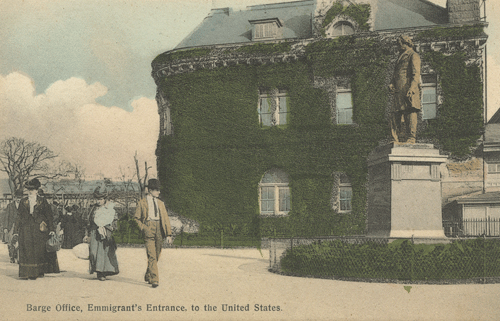 |
| Postcard collection of Maggie Land Blanck
|
| Barge Office, Emmigrant's Entrance to the United States
|
|
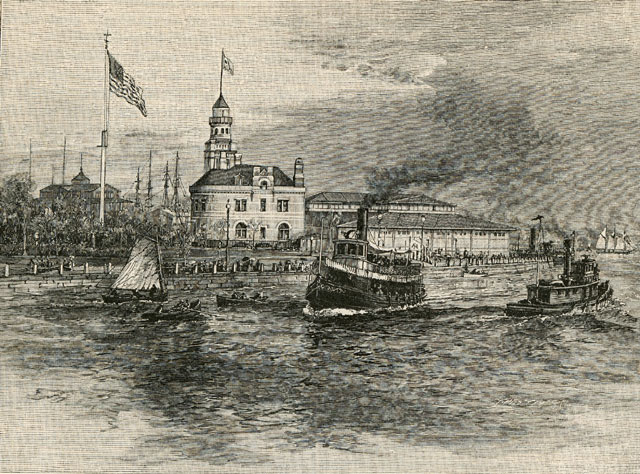 |
| Print Collection of Maggie Land Blanck
|
| The Barge OfficeHarper's June 1884
|
|
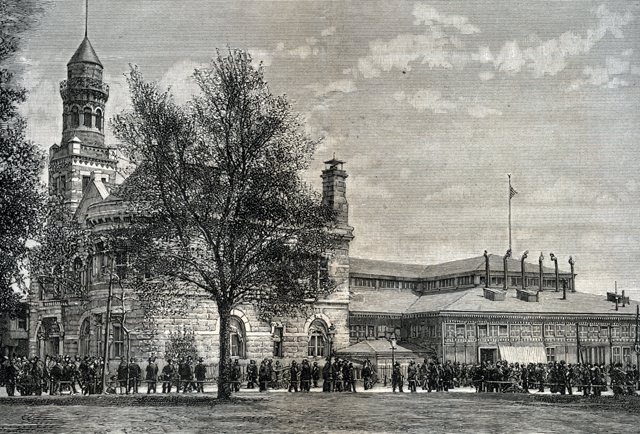 |
| Print
collection
of Maggie Land Blanck THE BARGE OFFICE AT BATTERY PARK, WHERE
ALL IMMIGRANTS ARE LANDED
Frank Leslie's Illustrated Newspaper June 13, 1891
|
|
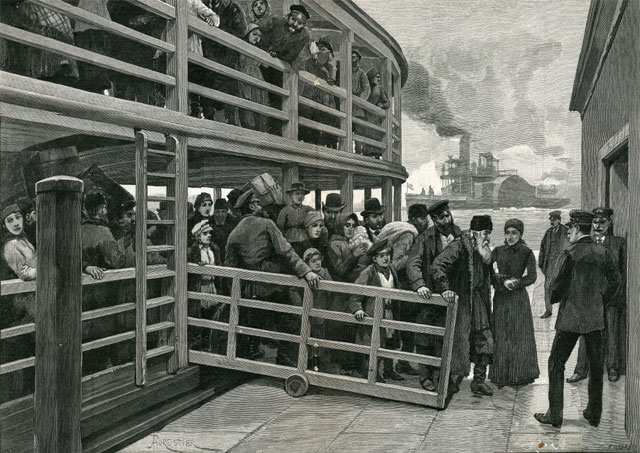 |
| Print Collection of Maggie Land Blanck
|
| Russian Emigrants Landing From the Tender at the Barge
Office, New York The Illustrated London News March 5, 1892.
Note: Ellis Island opened January 1, 1892.
|
|
| Ellis Island
The altruistic explanation for the establishment of Ellis Island insinuates it was
for the comfort and safty of the immigrants. There were, however, darker forces at work.
Robert A, Chesebrough, who patented Vasoline and made his fortune, was also a real
estate developer who bought property at Battery Park in the late 1800s. The area at
the time was
run down, but Chesebrough and his son, William, chose to build several office
buildings overlooking the waterfront. Unfortunately, the view also
included "unattractive strangers and emigrants" debarking at Castle Gardens.
Chesebrough petitioned Congress to have the immigration station
removed to Ellis Island. "He vigorously opposed the use of Castle Garden as an immigrant
depot by the state, and to his continued efforts is directly traced
the action of the general government in taking charge of the department and
removing it to Ellis Island."" (The National cyclopaedia of
American biography: being the history ..., Volume 3, 1893)
Ellis Island was opened on January 1, 1892.
All immigrants (including the Irish Langans in 1892 and the Armenian Azarians in 1920/21) who
came into the port of New York between 1892 and 1924 went through Ellis Island. However,
due to a fire
on June 14, 1897 that destroyed the complex, the island was closed until December 19, 1900.
During this period the Barge Office was again used to process immigrants. The process
for inspecting the immigrants during the years 1897 to 1900 was the same.
After a ship entered New York Harbor, immigration inspectors and United States health officers
boarded the ship. All steerage passengers were transfer from the ship by ferry to the island.
Passengers debarked with their luggage and were tagged with a card that included the page
and
line number corresponding to how their names appeared on the ship's manifest.
On the main floor of
the main building passengers were advised to check their luggage before going through the
inspection process. They could keep their bags with them if they wanted, but it was easier to
go
through the inspection without dragging one's possessions. Next they walked single file up the
grand staircase, which enabled health inspectors to do a quick check for lameness and other
physical problems that would appear while moving. On the second floor was the registry room
where US health officials examined the immigrants. Immigrants were checked for contagious eye
diseases and about fifty other ailments and conditions. Health officials marked the outer
garment of anyone with a health problem with a letter in chalk: an E for eye problem, an H for
heart, a B for lameness, etc. About 20% would receive chalk marks and be held for closer
examination. After the physical exam passengers lined up for the legal inspection conducted
by the immigration inspectors. Immigration inspectors, assisted by interpreters when
necessary, questioned each immigrant to confirm the information that had been declared
before sailing as it was listed on the ship manifest. The questioning lasted two or three
minutes and 80% of the immigrants had no problem with it. If there was some problem,
the immigrant was sent before a special inquiry Board. The Federal Immigration Act of
1917 required that every immigrant over the age of 14 could read. The test consisted of
reading a passage from the Holy Scriptures from the given passenger's culture and language.
Most immigrants found ways of passing the test even if the could barely read. Once these examinations
were finished the immigrant was free to leave. However, unaccompanied single women and
their children were not allowed to enter the US by themselves and had to wait until a male
relative came to fetch them. In 1921 Lucy Azarian and her three daughters, Annik, Heghine, and Zabel
were detained at Ellis Island for three days until Abram Azarian came to fetch them.
Between 1892 and 1924, 16 million immigrants passed through the Ellis Island, an amazing 71% of all immigrants who came into the United States during that time period.
Matthias, Penelope, James, and Bridget Langan went through Ellis Island when it first opened in 1892.
The Azarian family went though Ellis Island in the early 1920's.
|
|
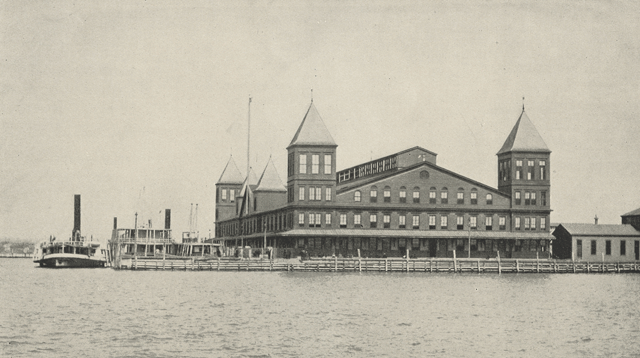 |
| Immigrants' Landing Ellis Island, New York Harbor
Ellis Island was originally the home of
Fort Gibson. Some of the old fort buildings were used
by the immigration authorities. The above images is of the first immigration processing
center on Ellis Island.
Two stories high and 400 feet by 150 feet, it
was constructed of Georgia pine covered with a thin coating of galvanized iron
and had a slate roof. This building burned in 1897.
|
|
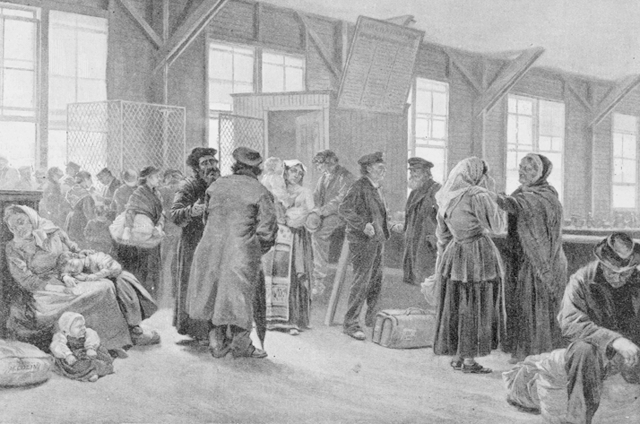 |
| Detained immigrants on Ellis Island, New York harbor / Drawn by M. Colin. Illus. in: Harper's weekly, 1893 Aug. 26, p. 821 Credit: American Memory collections from the Library of Congress.
This image is of the older building complex on Ellis Island. |
|
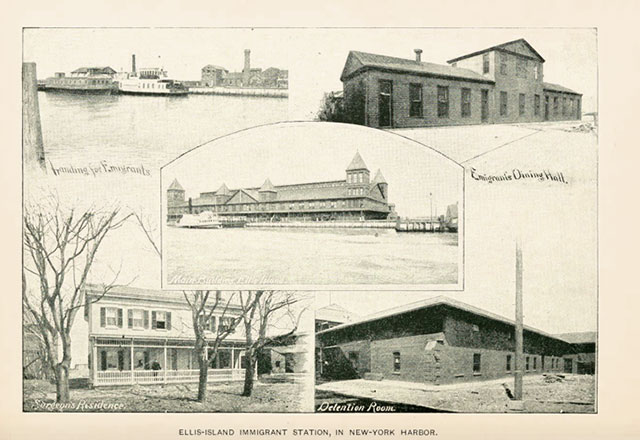 |
| King's Photographic views of New York by Moses King (1895), Google Book July 2013
This images in from King's Photographic vies of New York by Moses King (1895) shows the old complex at Ellis Island. The new building was
opened in 1892. Images of the pre 1892 building are rare.
The image shows five scenes: Landing for Emigrants, Emigrants Dining Hall,
Main Building Ellis Island, Surgeons' Residence, Detention Room and is labeled ELLIS-ISLAND IMMIGRANT
STATION, IN NEW-YORK HARBOR - THE LANDING FOR IMMIGRANTS.
|
|
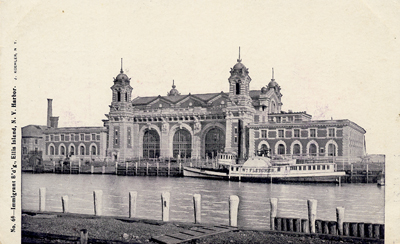 |
Immigration B'd'g., Ellis Island, N. Y. Harbor.
No date. |
| Post card collection of Maggie Land Blanck |
|
| Ellis Island, New York Harbor.
Post card dated 1919. |
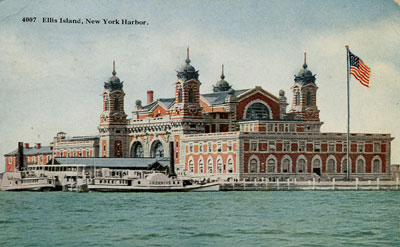 |
| Post card collection of Maggie Land Blanck |
Printed on back.
Ellis IslandImmigration Depot since 1892, where all immigrants are landed and examined
before being admitted to this country. Undesirables are deported at the expense of the
steamship company that brings them. Visitors are admitted to the balcony free.
Ferry connections form the Bowery. |
|
 |
Statue of Liberty on Bedloe's Island, Ellis Island, New
York Bay, Aerial Explorations, Inc.
Post card dated 1958. |
| Post card collection of Maggie Land Blanck |
|
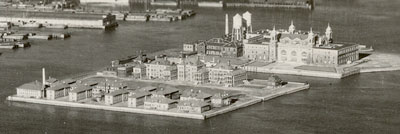 |
Ellis Island, New
York Bay, Aerial Explorations, Inc.
From above post card |
| Post card collection of Maggie Land Blanck |
|
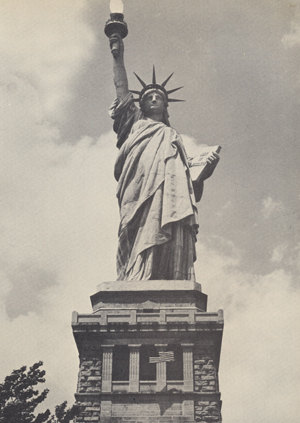
| The Statue of Liberty
The Statue of Liberty was dedicated on October 28, 1886. It was one of the first
sights immigrants had when arriving in New York Harbor. |
| New York City, State, and Nation by Sol Holt, a 1955 Junior High School
civics book. |
|
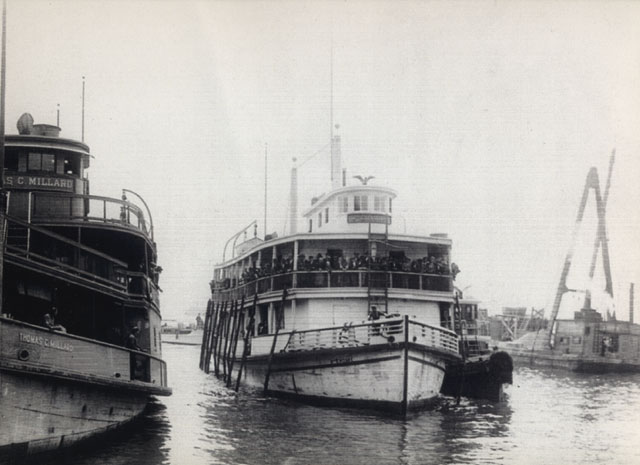 |
| Collection of Maggie Land Blanck
Ferry bring immigrants either from the ship to Ellis Island or from
Ellis Island back to the docks in New York City.
|
|
|
|
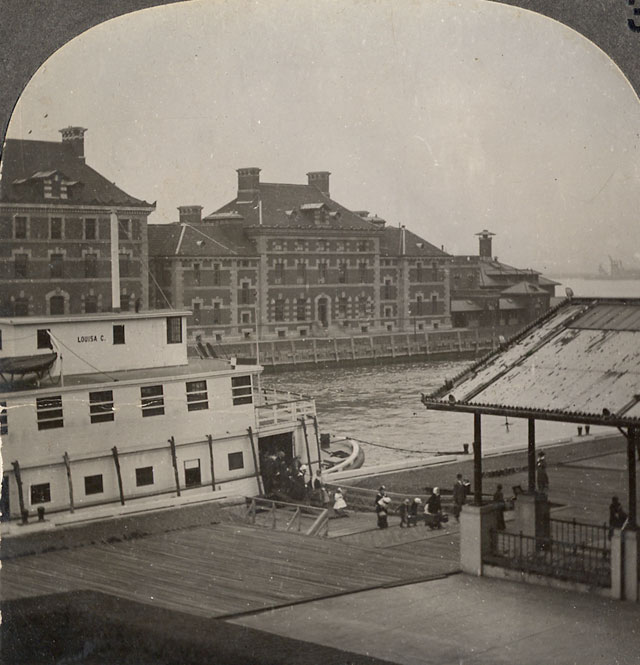 |
| Collection of Maggie Land Blanck
|
| The Gateway of America-Immigrants Landing from
Barge at Ellis Island, N. Y.
Printed on the back of this stereo card:
Ellis Island is a small island in the harbor of New York not far from the Statue of Liberty. Here are brought all immigrants who come into America through the port of New York. In order to understand the working of the government machinery about a port, imagine yourself an immigrant on board a large in-coming ship.
The vessel first puts into its pier where American citizens and others whose landing is not to be questioned, get off. All immigrants are kept on board, you among them. A ferry pulls alongside the ship and you are taken aboard it. This boat takes you to Ellis Island. Perhaps your ferry that you see draws alongside the Ellis Island Pier. You will note the immigrants stepping for the first time on American soil.
Before you are free to go to your friends, you must undergo a government inspection. With many others you pas into narrow aisles formed by iron railings. At the end of each of these aisles, in a booth, stands a government inspector. When you finally reach him, you under a careful examination.
You give you name, your age, your occupation, tell who your friends are, where they live, and what you expect to do*. You must have a certain amount of money on your person in order that the Government may be assured that it will not have to support you when you land. You are also given an examination by special doctors. If you fail to satisfy the authorities on any of these items, you will not be admitted.
More immigrants come through the port of New York than any other port in America. In 1914 there were received at Ellis Island, 1,218,490 immigrants, 33,041 of whom were debarred.
*This information was actually taken before the ship left Europe and was only reaffirmed upon arrival in New York.
|
|
 |
| Collection of Maggie Land Blanck, Century Magazine May 1903 from an
article by Jacob Riis with
illustrations by G. W. Peters (George W Peters) Going from the ferry
to the main entrance of the immigration building at Ellis Island.
|
|
|
|
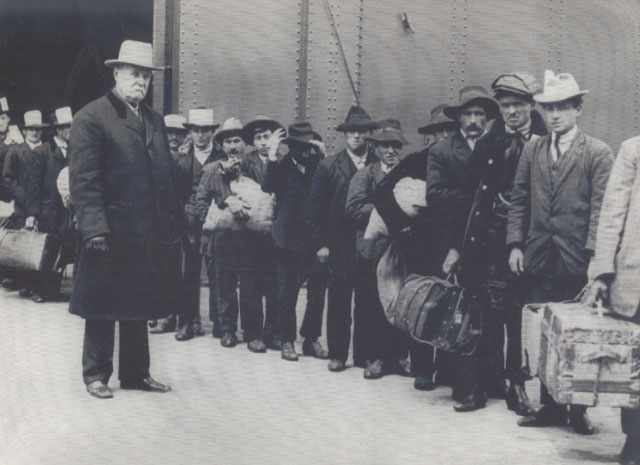 |
| Collection of Maggie Land Blanck
|
|
|
|
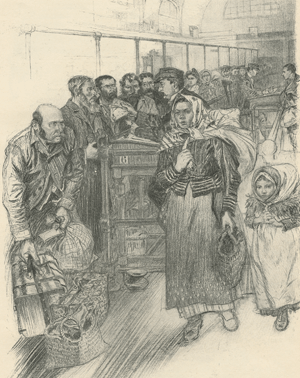 |
| Collection of Maggie Land Blanck, Century Magazine May 1903 from an
article by Jacob Riis with
illustrations by G. W. Peters (George W Peters) THE REGISTRY DESK, ELLIS ISLAND
|
|
|
|
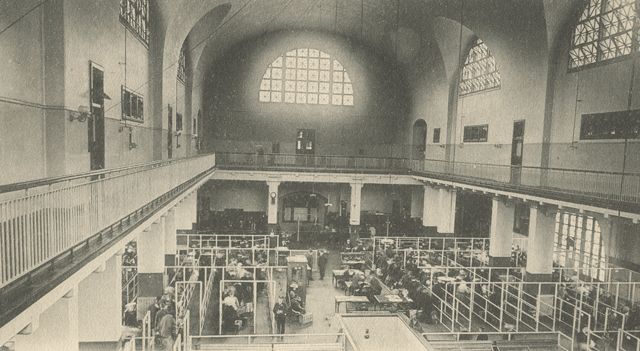 |
| Collection of Maggie Land Blanck
|
| Registration Room, Ellis Island, N.Y. City copyright 1905 by the
Rotograph Co.
|
|
 |
| Collection of Maggie Land Blanck
|
| Ellis Island, New York, Inspection room
Not posted
|
|
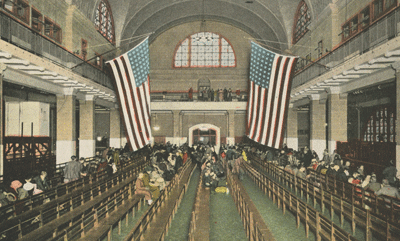 |
| Collection of Maggie Land Blanck
|
| U. S Immigration Station, Ellis Island, New York
1925 D. T. Magowan, Maplewood, N. J.
Not posted
Printed on back:
U.S. IMMIGRATION STATION
ELLIS ISLAND, NEW YORK
Aliens appearing before immigrant inspectors for
primary examination after having been passed by medical officers
|
|
 |
| Collection of Maggie Land Blanck, Century Magazine May 1903 from an article by Jacob Riis with
illustrations by G. W. Peters (George W Peters)
IMMIGRANTS LANDING AT ELLIS ISLAND — SERVING SOUP ON THE ROOF GARDEN
|
|
|
|
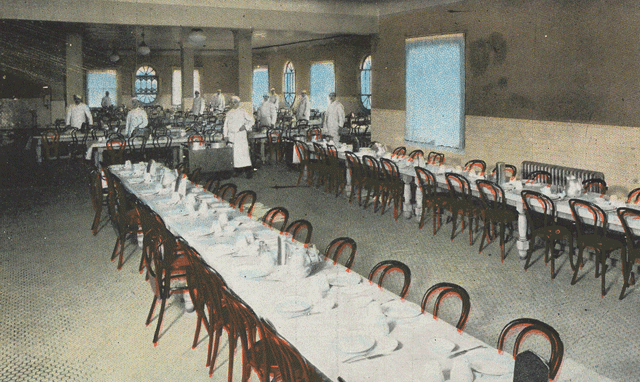 |
| Collection of Maggie Land Blanck
|
| U. S Immigration Station, Ellis Island, New York
Dining room
Not posted
Printed on back:
U.S. IMMIGRATION STATION
ELLIS ISLAND, NEW YORK
Dining room, seating 400. Those detained are furnished three meals daily
during the period of their detention. Also crackers and milk
are served throughout the day and at bed time to
women and children
|
|
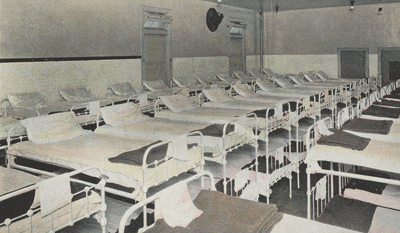 |
| Collection of Maggie Land Blanck
|
| U. S Immigration Station, Ellis Island, New York
1925 D. T. Magowan, Maplewood, N. J.
Not posted
Printed on back:
U.S. IMMIGRATION STATION
ELLIS ISLAND, NEW YORK
Sanitary, well-ventilated and
comfortable dormitories insure rest for those detained over night.
|
|
 |
| Collection of Maggie Land Blanck
|
| U. S Immigration Station, Ellis Island, New York
Board of Special Inquiry, 1925 D. T. Magowan, Maplewood, N. J.
Not posted
Printed on back:
U.S. IMMIGRATION STATION
ELLIS ISLAND, NEW YORK
Board of Special Inquiry
All aliens found to be not clearly
and beyond a doubt entitled to land are
examined at length to determine their
admissability
|
|
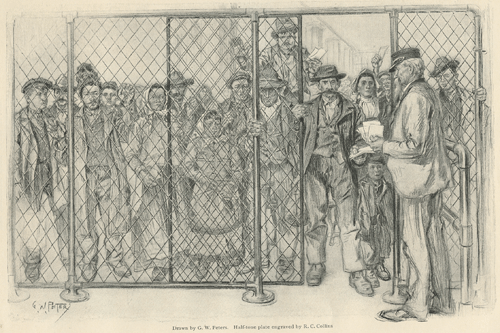 |
| Collection of Maggie Land Blanck, Century Magazine May 1903 from an
article by Jacob Riis with
illustrations by G. W. Peters (George W Peters) THE NEW YORK DETENTION-ROOM, ELLIS ISLAND
|
|
|
|
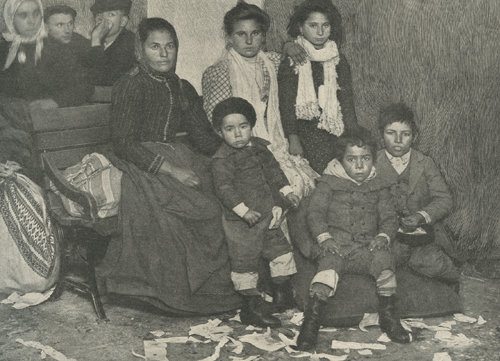
|
| Harpers Weekly June 19, 1901
collection of Maggie Land Blanck
Prospective American Citizens
|
|
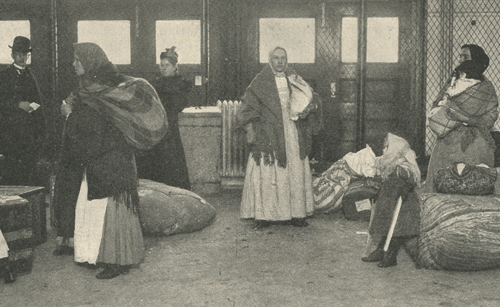
|
| Harpers Weekly June 19, 1901
collection of Maggie Land Blanck
The Baggage-room
|
|
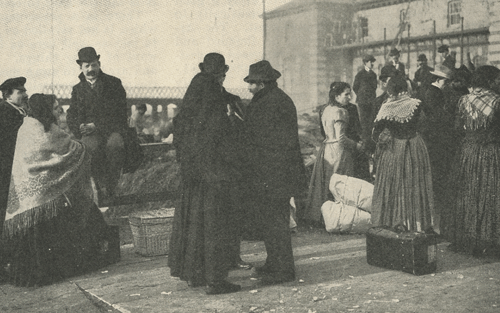
|
| Harpers Weekly June 19, 1901
collection of Maggie Land Blanck
Waiting for the New York Boat
|
Harpers Weekly, June 19 1901
The New Clearing House for Immigrants
"On Ellis Island, in New York Harbor, the government as opened a
handsome new clearing-house for immigrants. The structure was built to take
the place of the ramshackle pavilion of wood and slate which, in 1897,
was burned to the ground. After the destruction of the old building the
inspection of immigrants was conducted in a stuffy and ill-smelling shed
attached to the Barge Office. In this narrow space six thousand aliens a
week were herded. They were gathered in pens, sent to sleep under the
rafters with layers of hot air for coverlets, and hurried about by frantic
persons who waved papers and scowled. Now the candidates for American
citizenship are entertained in a building as well arranged as many a
hotel, until the Commissioner of Immigrations decides whether or not he can
accept them as residents of the United States."
The size of the island had been increased by approximately 4 acres during the renovations.
"The main building is 338 feet long and 168 feet wide.
It is built of brick held in the Flemish bond, and ornamented with trimmings of limestone.
In this building the registry-room occupies more space than any other apartment. It is 200 feet
long, 100 feet wide, and 56 feet high. Most of its floor space is divided by means of iron railings into twelve narrow alleys. Down these passages are marched the files of immigrants. The new-comers whose names have been properly entered on the manifest of the steamer are permitted to pass, provided they have no diseases, no prison record, and no desire to become a beggar. If they have money enough or if their friends are present to guarantee that they are provided with funds to carry them to their destinations, they are permitted to try conclusions with the baggage-men and railroad ticket-agents on the floor below.
Those upon whom suspicion rest are escorted to the Detention Pen. From that
enclosure they are taken to the meeting of a special board, which frequently
orders them deported. In the central pavilion are a telegraph office, a bureau for
changing money, sleeping apartments, the executive offices and a hall of records."
|
Who Actually Went Through The Immigrant
Processing Stations
|
|
| The immigrant proceedings stations were set up to screen non US citizens
who were
traveling in steerage.
All those (whether US citizens or not) who were traveling 1st or 2nd class
were disembarked on the piers.
US citizens who were traveling in steerage were disembarked on the piers.
All non US citizens traveling in steerage went through Castle Gardens,
the Barge Office or Ellis Island depending on the time frame.
An interesting case was brought to my attention in February 2012 by Kathy Clime whose ancestor
Josef Kozole entered the port of New York three times: 1905, 1912 and 1922.
Josef Kozole born in Blanca, Slovakia in 1884 arrived in the United States
for the first time
on August 10, 1905 on the Barbarossa from Bremen on his way to Philadelphia. As a non US citizen in steerage he was processed
through Ellis Island.
Sometime later Josef returned to his homeland and married.
He and his bride came to America as "Second Cabin" passengers on the
Kronprinz Wilhelm on March 5, 1912. He was not a US citizen at
the time but was traveling Second Class and as such he and his wife, Marie,
would not have
been processed at Ellis Island but have
disembarked directly on the piers in Hoboken.
In 1922 Josef and Marie brought their four children back to Yugoslavia for a visit.
They returned to the US on August 18 1922 on the Aquitania from Cherbourg to New York.
The children ages 10 to 5 were all born in the United States and as such
were US citizens. They were listed on page 74 of the ships manifest.
Josef and Maria were listed on page 88 of the ships manifest and were not US citizens.
The question was: Would the children, as US citizens, been disembarked on the piers or
would they have gone though the immigration process at Ellis Island, a necessity for
Josef and Marie as non citizens?
Jeffrey S. Dosik,
Librarian,
National Park Service,
Bob Hope Memorial Library,
Statue of Liberty NM &
Ellis Island
said that his educated guess would be that the American born children
would not have been separated from their immigrant parents.
They would have passed through Ellis together as a family and would
have shown documentation to U.S. Immigration officials that their
children were American born.
|
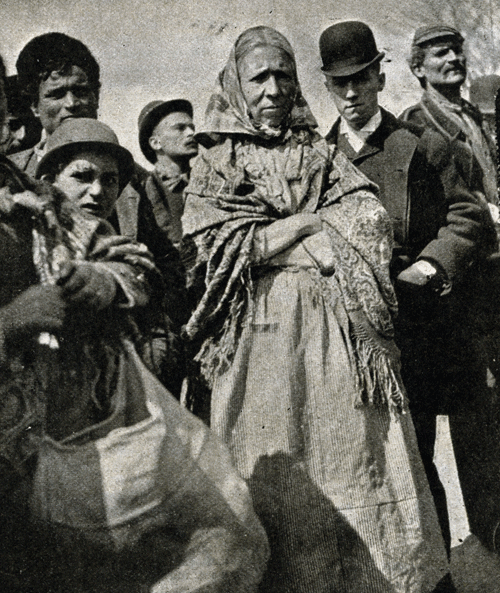 |
| Print
collection
of Maggie Land Blanck
Frank Leslie's Illustrated Newspaper June 13, 1891
|
|
 |
| Print
collection
of Maggie Land Blanck
Frank Leslie's Illustrated Newspaper June 13, 1891
|
|
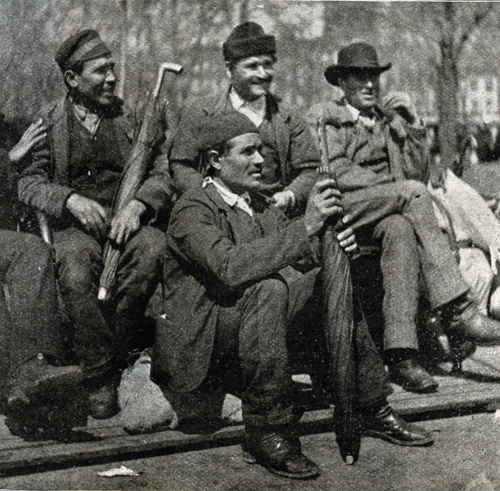 |
| Print
collection
of Maggie Land Blanck
Frank Leslie's Illustrated Newspaper June 13, 1891
|
|
|
Battery Park
|
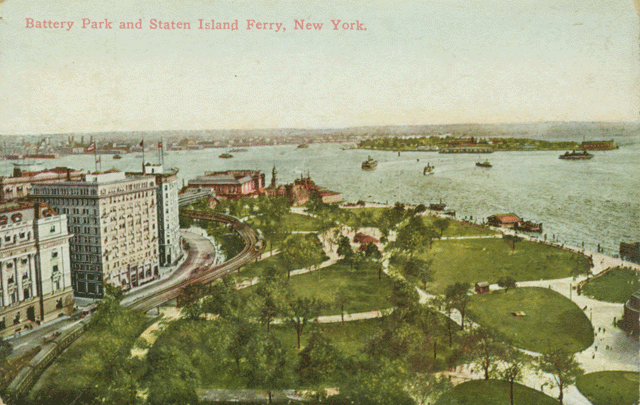 |
| Photo courtesy of Murray Gauer, December 2009
|
The Next Stage of the Journey
The majority of immigrants did not stop in their port of debarkation. Just as some
emigrants left from ports not in their home country (like Germans leaving from Liverpool)
many immigrants did not arrive in the port where they intended to settle.
Joseph Walsh whose final destination was New York City arrived in the port of Philadelphia.
Conversely,
Lydia Land and her children whose final destination was Philadelphia arrived in the port of New York.
New York was by far the largest port of entry for those arriving from overseas to the east coast.
Many would not stop in New York even for the night but would immediately make their way to
the trains and boats headed west.
No trains to the west terminated in Manhattan so it was necessary to get from
Castle Garden or Ellis Island to the train stations in New Jersey where Jersey City and Hoboken
were the terminals for the trains headed west, northwest, and south.
|
|
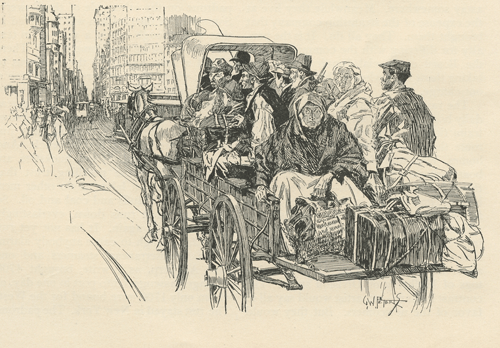 |
| Collection of Maggie Land Blanck, Century Magazine May 1903 from an
article by Jacob Riis with
illustrations by G. W. Peters (George W Peters)
|
|
|
|
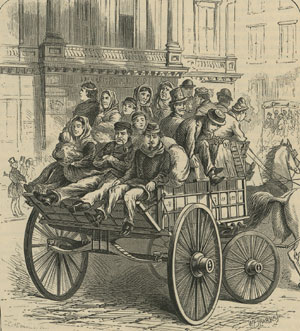 |
Immigrant Transfer - The Old Method
Christian Weekly March 28, 1874
|
| Magazine collection of Maggie Land Blanck
|
|
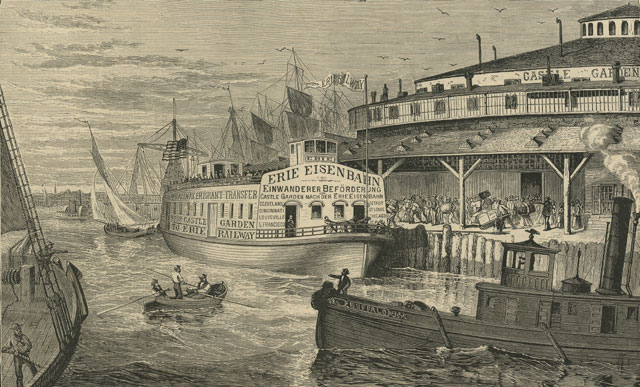 |
| Magazine collection of Maggie Land Blanck
Castle Garden, With Immigrant Transfer Barge
Christian Weekly March 28, 1874
Eventually barge transfer from Castle Garden directly to the Hoboken and Jersey
City was instituted.
The signs on this barge reads:
Railway Emigrant Transfer, from
Castle
Garden to Erie Railway
Erie Basin Bahn
Einwanderer Beförderung
Castle Garden Nach Der Erie Eisenbahn
Cleveland, Cincinnati, Louisville, S. Francisco, Detroit, St Louis, Chicago, St Paul
|
|
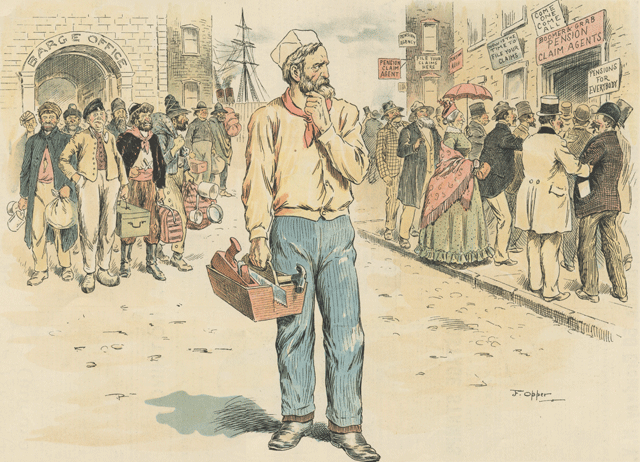
|
| Collection of Maggie Land Blanck
TWO CRYING EVILS
"Unrestricted Immigration and Unlimited Wast of Public Money - The Workingman suffers from both"
PUCK May 6, 1891
|
|
|
Naturalization
The naturalization laws are somewhat complicated.
However, the basic facts and how they effected most immigrants were simple.
One of the most relevant laws was the immigration act of 1802 which specified
that "free, white aliens" could be admitted to citizenship if:
- They declared their intention to become citizens in a state, territorial, or federal court at least three years before becoming a citizen.
- Took an oath of allegiance to the United States.
- Had lived for at least 5 years in the United States and at least one year in the state in which they were applying for citizenship.
- Renounced allegiance to the foreign government they had left.
- Satisfied the court they were of good moral character and were willing to follow the principles set forth in the constitution.
Basically one could become a citizen in any court in the United States, county,
state, or federal. The alien filled out a Certificate of Intention to become
a citizen any time after he entered the United States. After the time requirement
for residency was met he could fill out the Petition for Naturalization. The last
step was to receive the Certificate of Naturalization which could occur anywhere
from a day or two to several weeks after the Petition for Naturalization.
Under this act all foreign born children became citizens with their father.
This did not require the father listing the names, ages and places of birth of his
children. Women's citizenship was more complicated and her citizenship could
be determined by either her father or her husband, depending on various
criteria and where she lived.
Aliens, male and female, were allowed to own property in many areas of
the United States. In some areas alien males were given the right to vote after
they had completed the Declaration of Intention, (even though they were not citizens).
Although women and children were citizens they could not vote.
Many immigrants came from countries where they had no citizen rights -
Irish Catholics - Germans from Kingdoms and Duchies.
By an Act of February 10, 1855 wives of alien citizens were granted citizenship
with their husbands. This did not require the husband listing any information about
his spouse. Women could not vote until the 19th amendment of Constitution was ratified in 1920.
Some minor change occurred over the years, but no major changes were made until 1906.
After 1906 it became mandatory for the applicant to provide the name, age, birth
place, marriage date and place of a spouse and the names, ages and birth places
of minor children. Children who reached their majority before the father became
a citizen had to apply in their own right. There are numerous cases of aliens thinking
they had become citizens under their father citizenship only to discover years
later, or maybe to never discover, that they were not citizens all along.
After 1906, regardless of the court in which the alien became naturalized,
the courts used a standard for the Petition of Naturalization and the Certificate of
Naturalization. These forms required much more information than previously and
consequently are much more interesting to the genealogist. They include the applicants age,
occupation, personal description, date and place of birth, citizenship,
present and last foreign address, ports of embarkation, and entry, name of
vessel date of arrival, spouses name, names and ages of children with their
places and dates of birth and finally the residency at the time of application.
Veritable gold mines of genealogical information.
Women continued to receive their citizenship through their husbands until 1922.
After 1922 they had to apply on their own behalf. Women were granted the right to
vote by the 19th Amendment of the Constitution which was passed in
1919 and ratified August 18, 1920.
What about children?
Did they continue to be under their fathers?
|
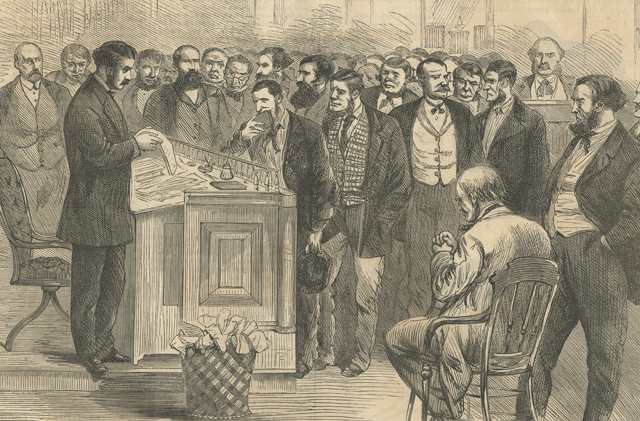
|
| Harpers Weekly October 10, 1868,
collection of Maggie Land Blanck
EXAMINING AND SWEARING NATURALIZED CITIZENS
|
|
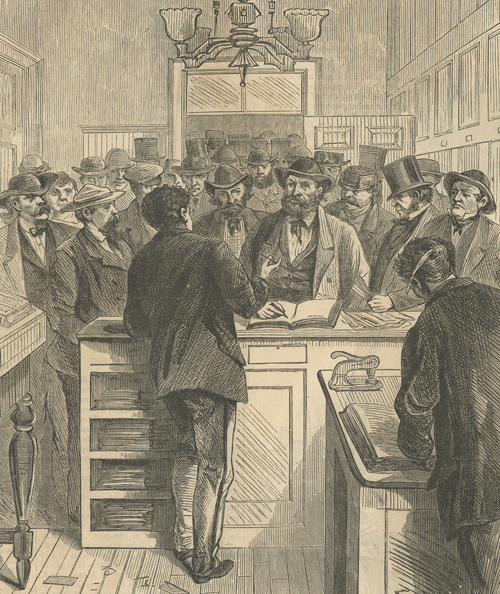
|
| Harpers Weekly October 10, 1868,
collection of Maggie Land Blanck
SECURING CERTIFICATES OF NATURALIZATION IN THE CLERK'S OFFICE, CITY HALL
" In view of the coming presidential election the manufacture of voters
in the various courts of New York city and county by naturalization
progresses with unusual vigor.....
.......... A common method of obtaining naturalization papers for voting purposes
is for the rascal applying to give a false address. In this way it is stated
that in 1867, one house, containing not more than four or five voters, was set down in a court
record as the residence of no fewer than sixty-eight applicants for naturalization.
The rate of manufacture at this time is about one hundred a day. Our engraving on this
page illustrates the method of obtaining the certificates. The would-be citizen first
visits the Naturalization Bureau room City Hall, and obtains a certificate
setting forth that he has made an
application for citizenship at that office, and that such and application had been duly filed
and the fees paid. With this stamped certificate he presents himself at the bar of
one of the city or county courts and undergoes
a cross-questioning on the part of the Judge. His friends or witnesses are
also examined as to his
character, antecedents, as to the length of his residence in the country, etc.
If he "passes" the Judge he presents himself at the desk of the clerk and takes the oath.
He is then a citizen."
Harpers Weekly, October 10, 1868
It would be very interesting to know it the statement about applicants
giving false information is true. It could certainly complicate the search for
documentation of ones ancestors.
|
|
|
The Immigration of the Land/Blanck Family
The earliest immigrants in the Land/Blanck story came to America from Germany around 1847. The most recently
arrived immigrants in the story came from Turkey in the 1920s. All of them represent in one way or another,
classic American immigration stories.
Most individuals did not migrate in isolation. From ancient times people moved in family groups.
The same was true of the major immigration movements to America.
The passenger lists are full of single men and women. However, the chances were good that these
single people were part of a group of relatives, friends, and neighbors who immigrated within a
few years of one another and settled in the same area.
This type of immigration is known as chain migration and is still occurring today.
Peak immigration years or the "crests of the migration waves" from Western Europe were 1849-54, 1869-73, and 1882-83.
German Ancestors Who Arrived in America Circa 1847
The first individuals in this story to arrive in America were Germans who immigrated in the middle of the
19th century. Julius Lindemann, Catherine Furst, and Louis Furst, all immigrated from Germany circa 1847. Julius and Catherine were married in New York and their children were born in New York.
They entered before the State of New York established immigration facilities at Castle Gardens.
German Ancestors Who Arrived in America in the 1870s
Henry Blanck and the Erxmeyer family came from Lehe, Germany to settle in Hoboken, New Jersey in the 1870s.
Peter Goehle, born in Hessen-Darmnstadt, Germany, immigrated to the United States on August 25th,
1873 on the R.M.S. Batavia from Liverpool and Queenstown and settled in New York City.
Peter Goehle was definitely processed through the New York State immigration facilities at Castle Gardens. Most likely Henry Blanck and the Erxmeyers also entered the United States through Castle Gardens.
German Ancestors Who Arrived in America in the 1880s
The 1880s were a period of peak immigration from Germany. Among the arriving immigrants were Frederick Kettler from Freisland and Bernhard Petermann and his family from Oldenburg.
Johanna Peter (or Peterson) is believed to have arrived from Norway around this time.
Frederick Kettler, Johanna Peter, and the Petermanns all spent some time in
Brooklyn before settling in Hoboken, New Jersey.
Frederick Kettler, the Petermanns and Johanna Peter most likely came through Castle Gardens.
English Ancestors to New York State 1850 and Philadelphia 1870s
The first known members of the Land family to emigrated were: -
James and Samuel Sykes who were in Ithaca, New York in the 1850s and subsequently moved to Canada.
- Samuel Land, the son of John Land and Mary Dyson, and his wife, Mary Ann Law, (the sister of Samuel's step mother, Lydia Law Land) and their children who immigrated to Philadelphia circa 1871.
- William the son of John Land and Mary Dyson, who was in Philadelphia between 1871 and 1875 and returned to England.
I do not know where any of them entered they entered the United States.
Lands and Sykes in Canada in the 1880s
Law Land, his wife, Elizabeth Sykes, and their child, Clarence immigrated to Toronto Canada circa 1882. Law and his family subsequently moved to Detroit Michigan circa 1892, to New Jersey, circa 1895, and finally to Smithtown, Long Island in 1900. I do not know where they entered Canada or the United States.
Elizabeth Sykes' brother, Samuel, immigrated to Toronto with his family on August 19, 1882 through Liverpool to Quebec. Another brother, Robert, immigrated to Toronto circa 1885. I do not know where they entered Canada.
Law Land's mother, Lydia, and several of her children immigrated though New York to Philadelphia in 1883. They entered the United States through Castle Gardens and most likely went by train to Philadelphia.
Irish Ancestors Who Arrived in the 1890s
The Langans and the Walshes came from Ireland in the early 1890's.
Maggie and Martin Langan could have come in though Castle Gardens circa 1890. Mathias, Penelopa, James and Bridget were among the first arrivals at Ellis Island in April 1892.
Joseph and Fanny Walsh immigrated to the United States on the British Princess, which left Queenstown, County Cork, Ireland on May 17th, 1894 and arrived in Philadelphia on May 29, 1894. I assume they traveled by train from Philadelphia to New York City
The Azarians in the 1920s
The Azarians, who were ethnic Armenians, came to America from Turkey through Ellis Island the early 1920's.
|
|
Ancestors Who May Have or Actually Did Enter
the United States
Through Castle Gardens, New York City
Several of the following actually did come through the Port of
New York and so must have come through Castle Gardens. This include
Melosine Erxmeyer (and her sisters and mother), Peter Goehle and
Lydia Land and her children.
The others may have come through another port. Henry Blanck
jumped ship in 1871 as did Melosine's brothers Fredrich and
Heinrich Erxmeyer.
- Catherine Furst, a Goehle ancestor, from Bavaria (Germany) circa 1847 - not
listed on the Castle Garden Web site.
- Julius Lindemann, a Goehle ancestor from Brunswick (Germany) circa 1847
- not
listed on the Castle Garden Web site.
- Henry Blanck, a Blanck ancestor from Hanover (Germany) 1871
- not
listed on the Castle Garden Web site. He jumped ship in August 1871.
- Melosine Erxmeyer, a Blanck ancestor from Hanover (Germany) in 1872.
- not
listed on the Castle Garden Web site. However, she must have entered through Castle Garden as I have
found her
immigration record. Her mother and sisters also entered through New York but are not listed at
Castle Garden.
- Peter Goehle, a Goehle ancestor from Hesse Darmstadt (Germany) in 1873
- not
listed on the Castle Garden Web site. However, he must have entered through Castle Garden as I have
found his
immigration record.
- Bernard and Sophia Petermann, a Land ancestor from Oldenburg (Germany) circa 1882
- not
listed on the Castle Garden Web site.
- Fritz Kettler, a Blanck ancestor from Friesland (Germany) before 1883
- not
listed on the Castle Garden Web site.
- Hanna Petersen, a Blanck ancestor from Norway before 1883.
- Maggie Langan, a Walsh ancestor from county Mayo, Ireland, circa 1890
- not
listed on the Castle Garden Web site.
- Lydia Law Land, an English ancestor from Yorkshire, England in 1883, and her children who are
the only ones so far listed by the
Castle Garden Web site.
Ancestors Who Entered the United States
Through Ellis Island, New York City
- Mathias and Penelope Langan and thier children James and Bridget, Walsh
ancestors, from County Mayo Ireland, April 1892. They are NOT listed by Ellis Island. However, I have found the ship manifest.
- Abram Azarian, an ethnic Armenian from Constantinople, Turkey,
October 1920.
- Lucy Azarian and her daughters, Anna, Mary, and Alice, ethnic
Armenians from Constantinople, April 1924
Ancestors Who Arrived Through Other Ports
-
Joseph Walsh, a Walsh ancestor from County Mayo, Ireland, entered the United States through
the port of Philadelphia in 1894
- Law Land and Elizabeth Sykes, Land ancestors from Yorkshire, England, first went to
Toronto Canada circa 1882. They subsequently entered the United States with several of
their children, including their son, Percy, through Detroit,
Michigan, circa 1892
|
|
| The Steerage of Today, 1898, Hubert Phelps Whitmarsh
After I bought the article "The Steerage of Today" by
H. Phelps Whitmarsh I found the entire article (with illustrations) on line at
Steerage Conditions in 1898 - A First-Hand Account
By H. Phelps Whitmarsh with Illustrations by A. Castaigne The
Gjenvick-Gjonvik Archives -
The Future of Our Past
Hubert P Whitmarsh age 33 author entered the US through the Port of New York
in steerage on the Lucania on June 27, 1896.
He made numerous other crossings as a cabin passenger under the name Hubert P and H Phelps Whitmarsh.
|
|
| George W Peters, Artist
George W Peters drew several of the images on this page.
According to a New York Times article of August 12, 1914 he had won fame
"by drawing pictures of scenes in the Philippines while
Aquinaldo was ravaging that country and who came very near being shot as a spy".
In 1914 he was sued by his wife Mary E for $40 a week alimony and $500 counsel fees.
Mary E Peters claimed it was her idea that her husband go to the
Philippines. She further claimed that George W Peters was living
with "a Mrs. Walcott" at 201 West Eighty-first Street.
G W Peters "the noted illustrator of New York City", was "born and reared" in
Lebanon, Pa according to Proceedings and addresses, Volume 14 By
Pennsylvania-German Society.
|
|
| Tenement Life
Many of the immigrants who arrived in New York
went on to live in the tenements of the Lower East Side. For more
information on and images of life in the tenements, go to
New York City Tenement life |
|
| Bremen/Bremerhaven
Many of the immigrants who arrived in New York, such as several of my ancestors,
left
from the German port of Bremen. For images of and information on Bremen go to
Bremer/Bremerhaven
|
|
